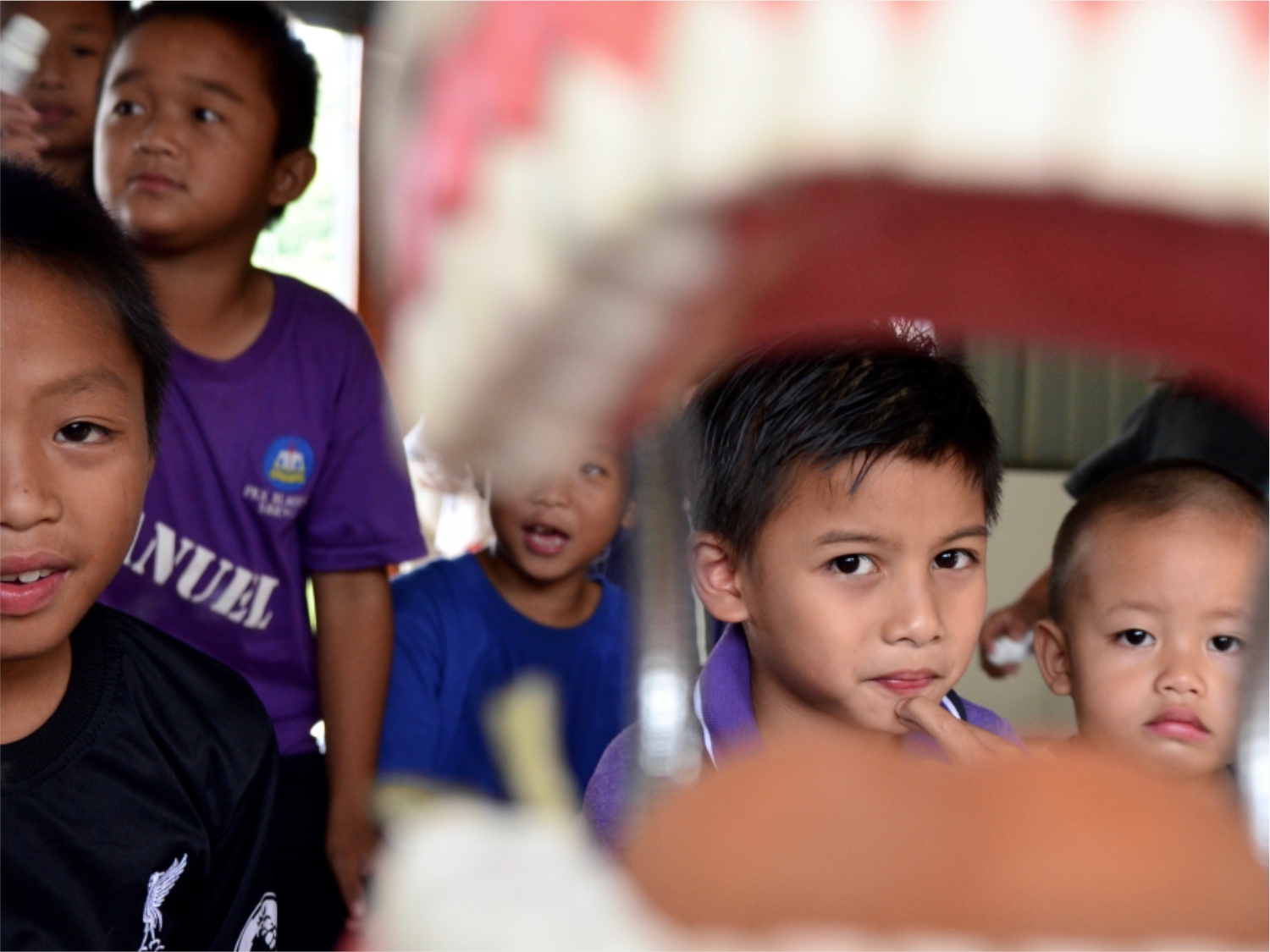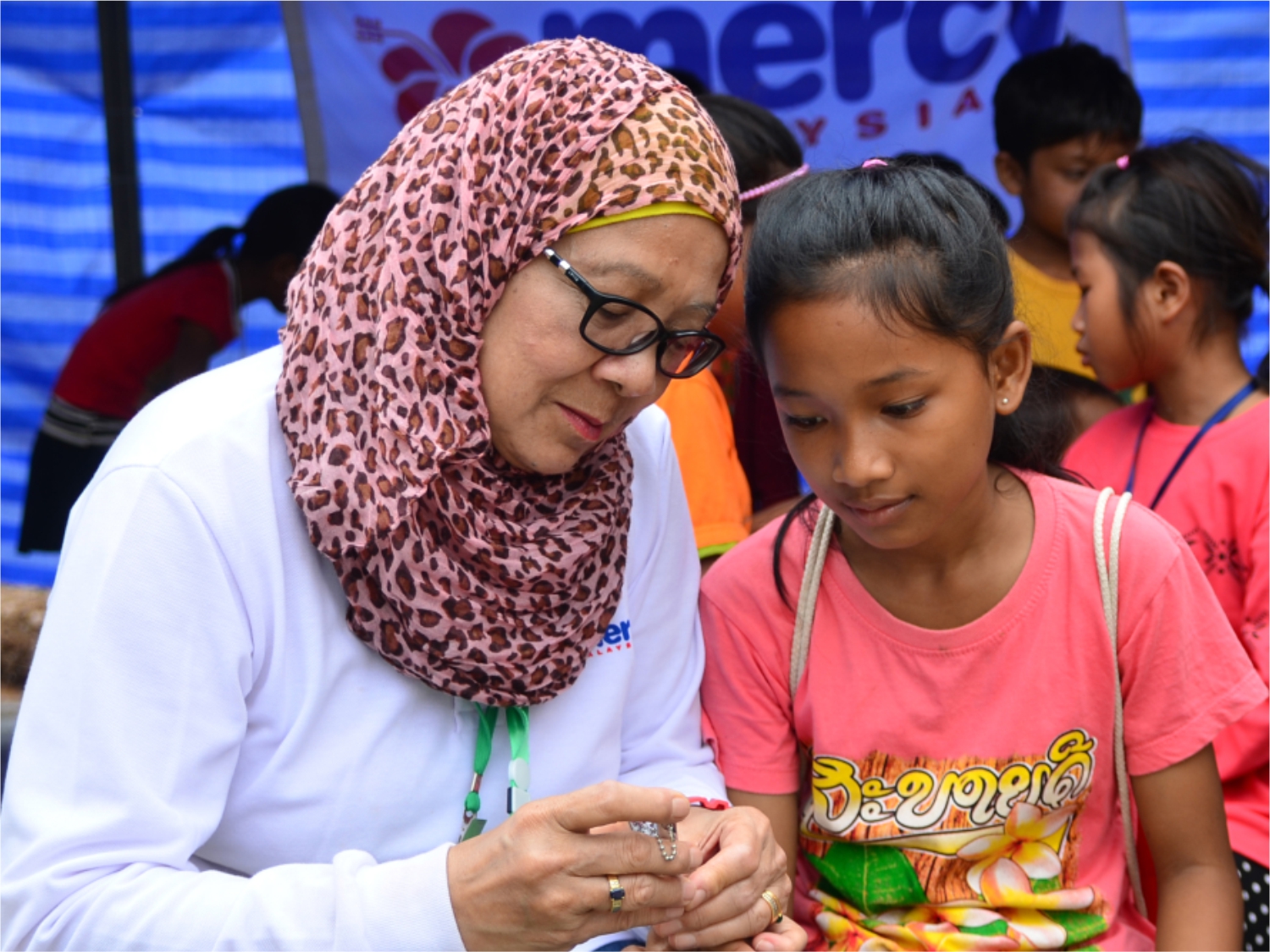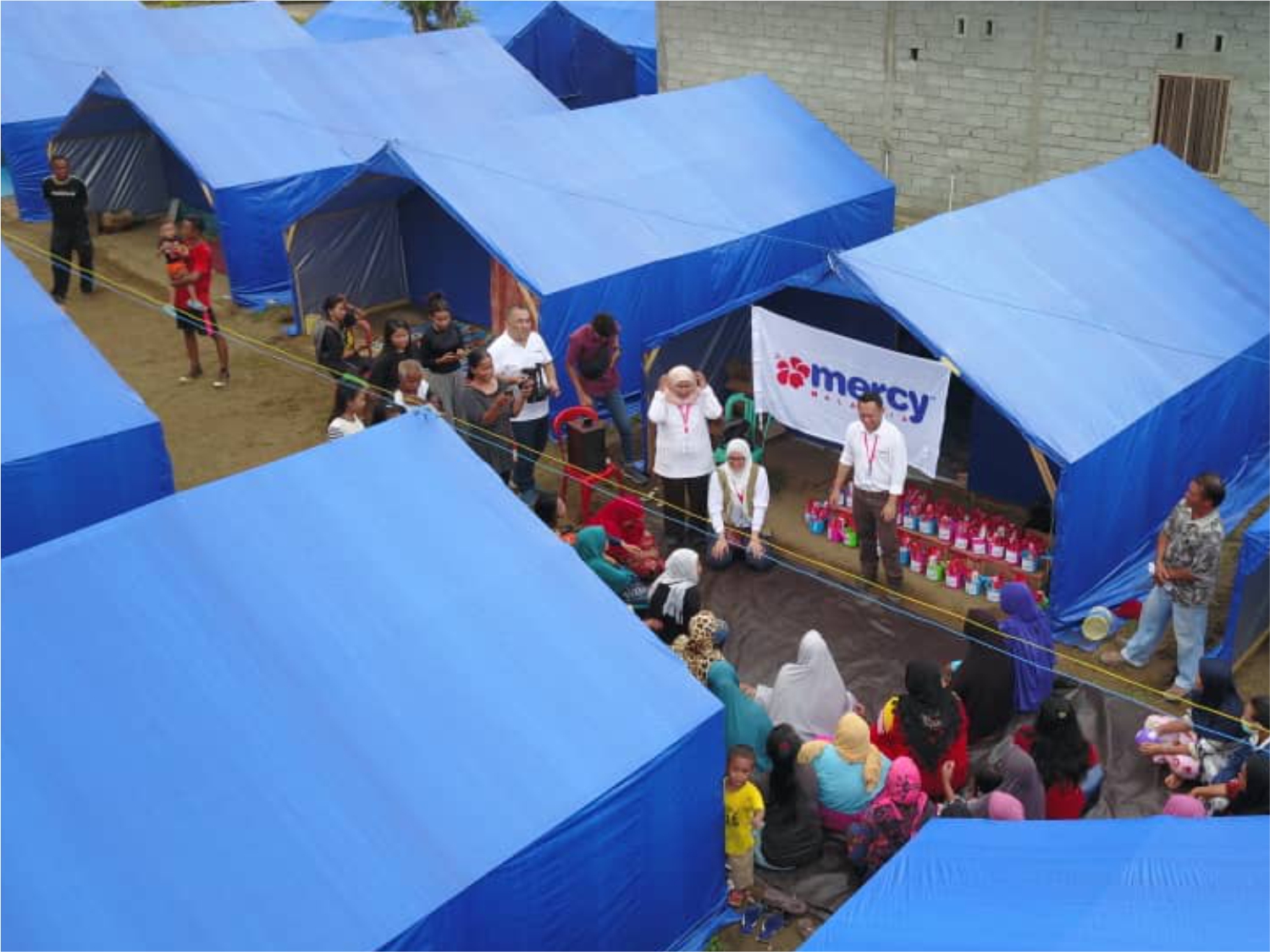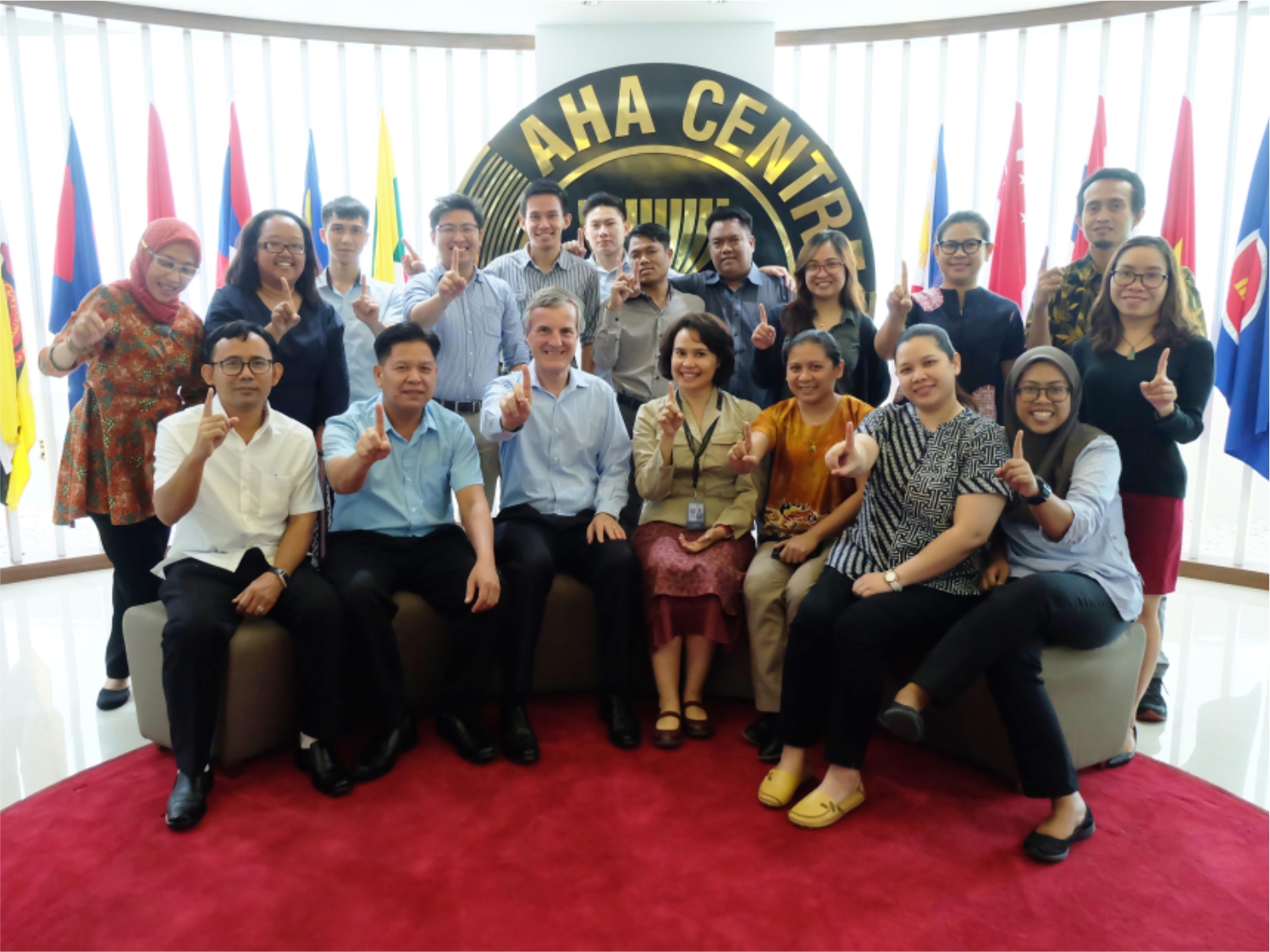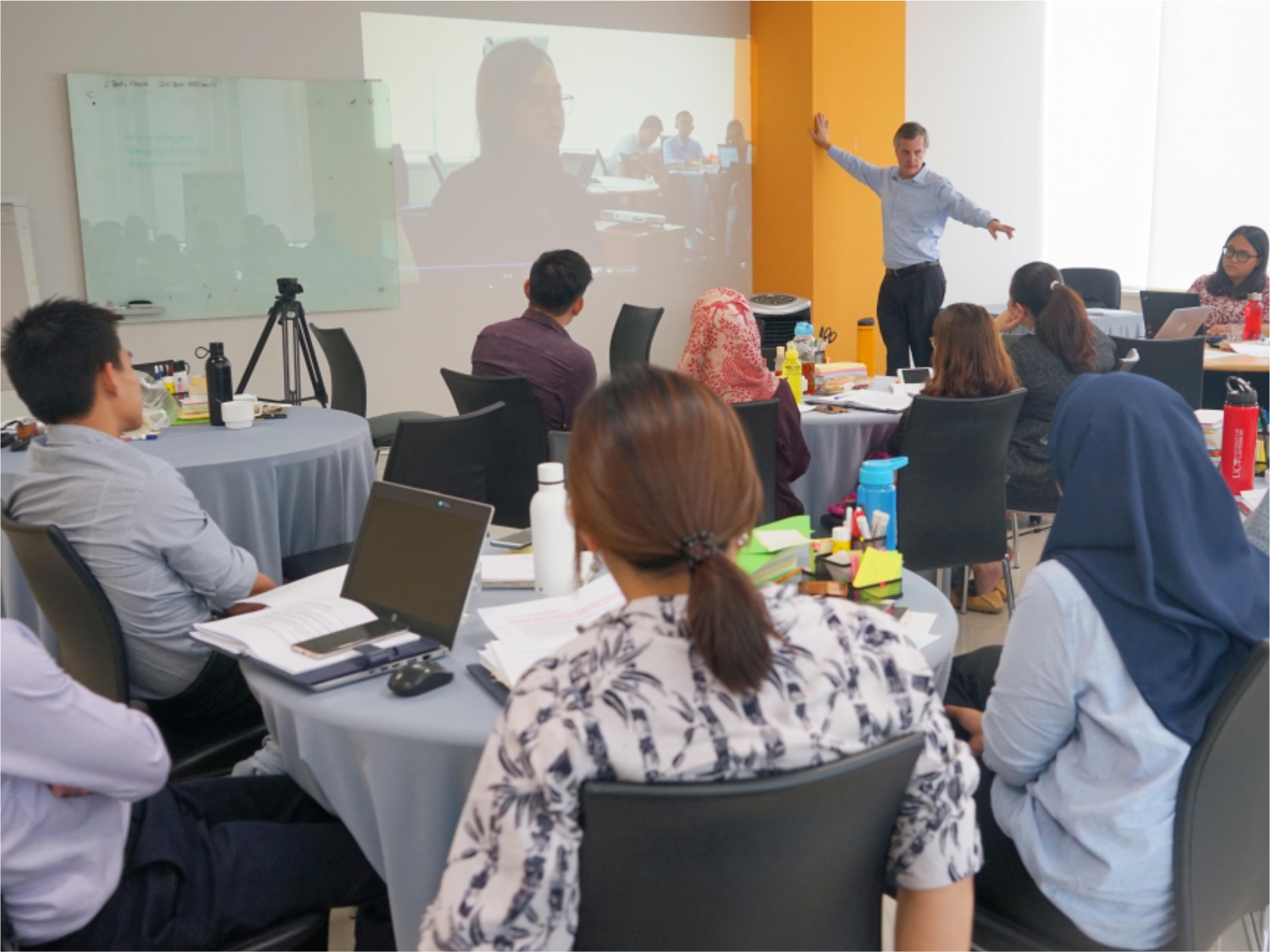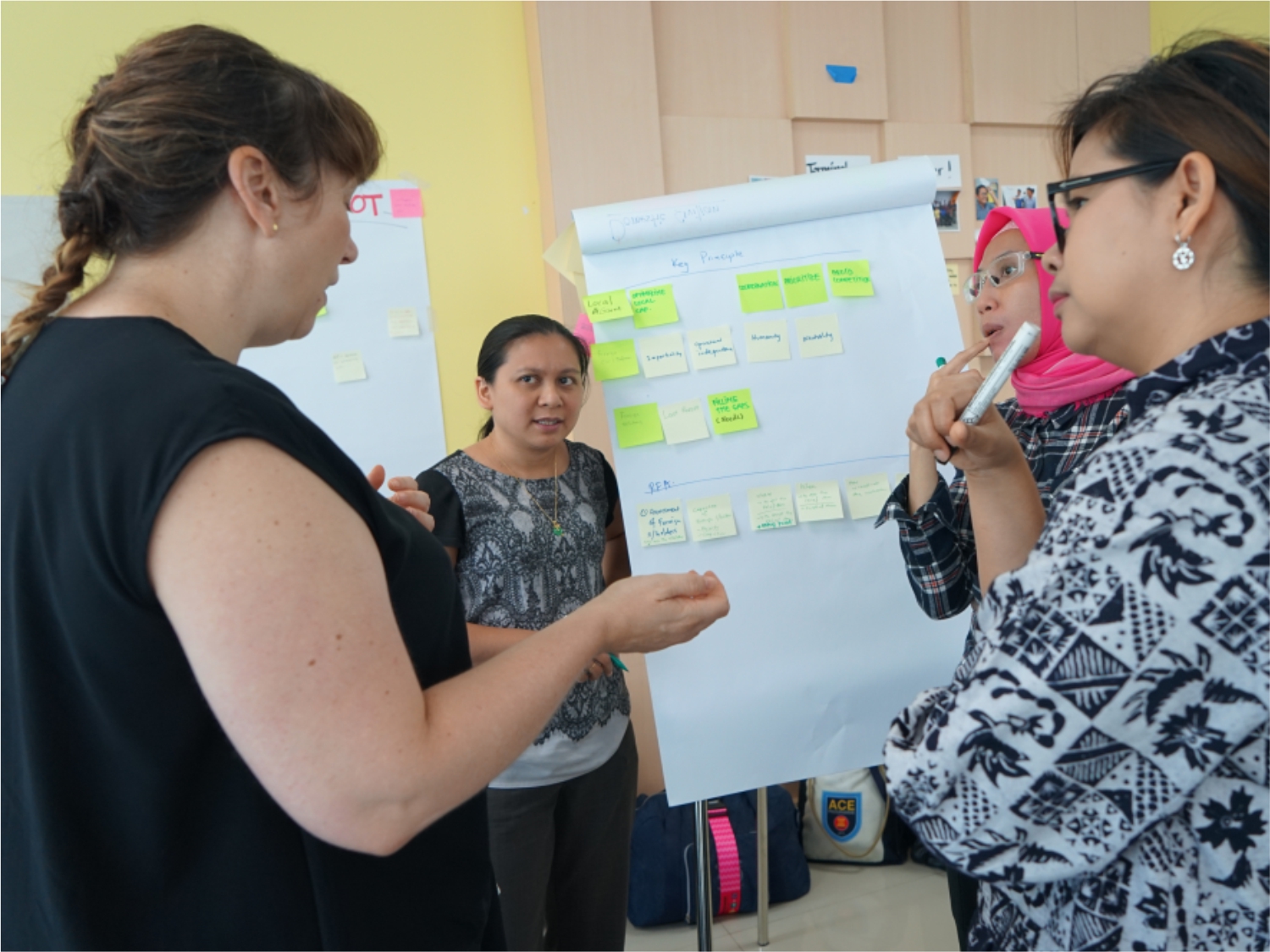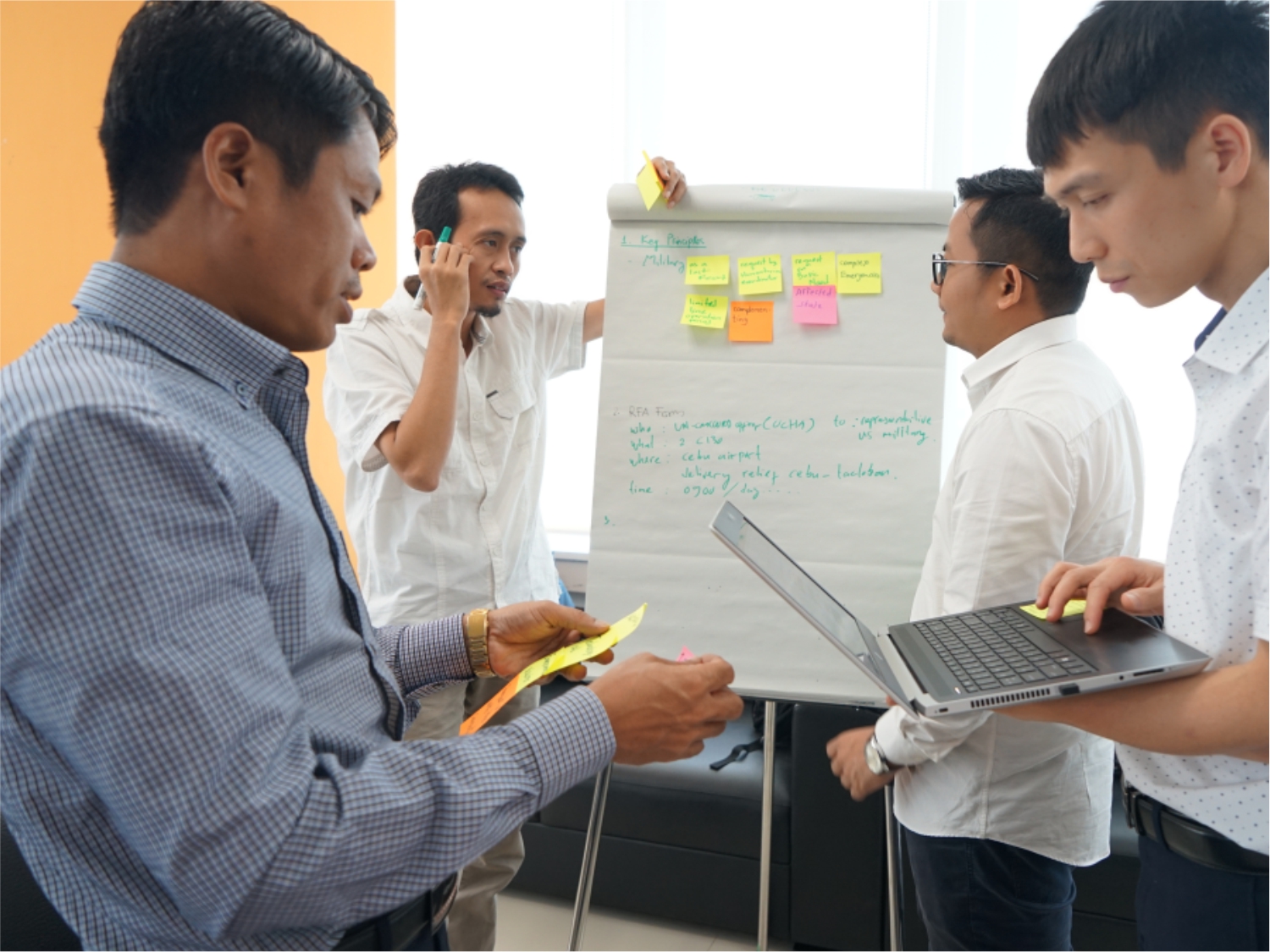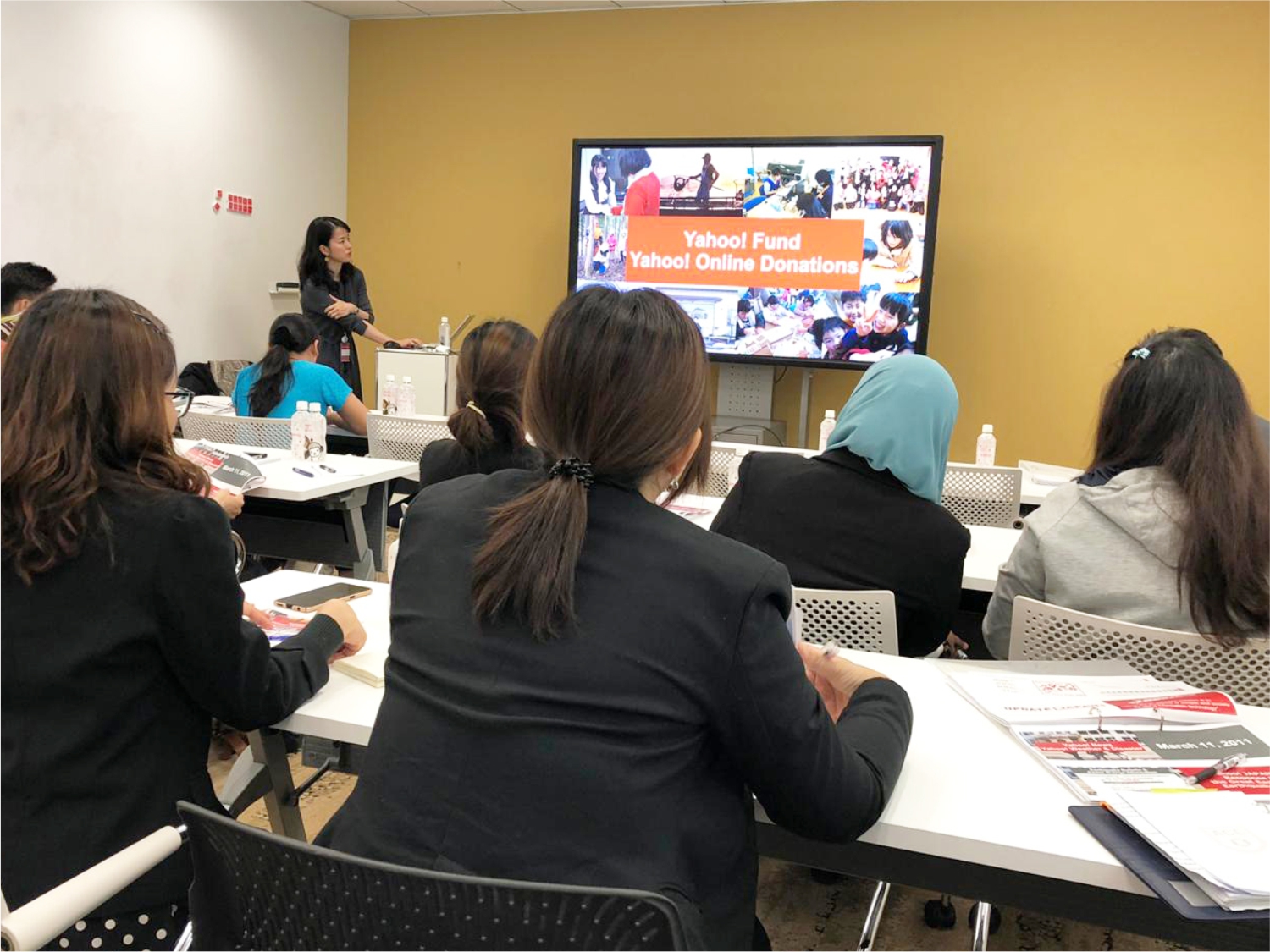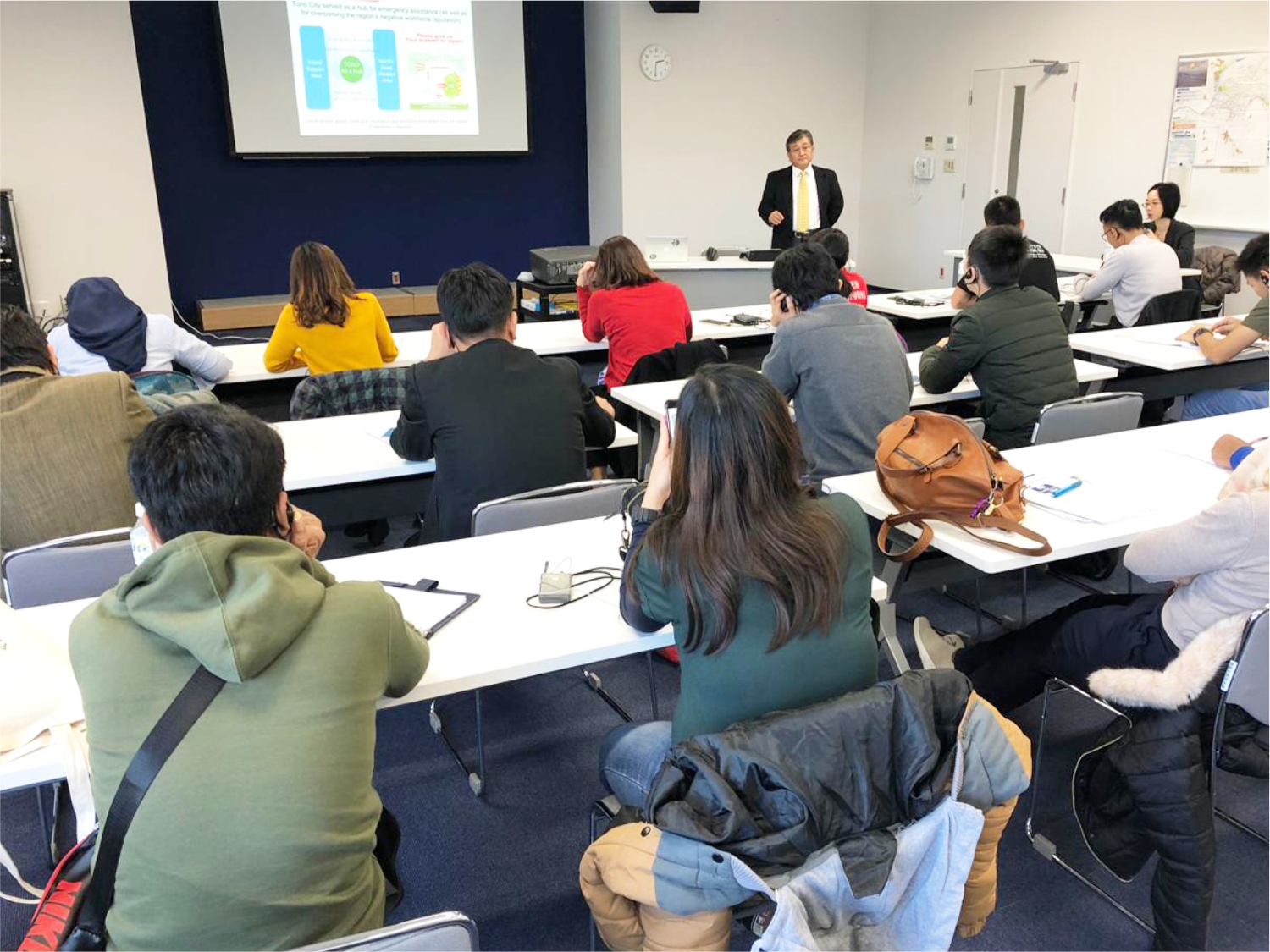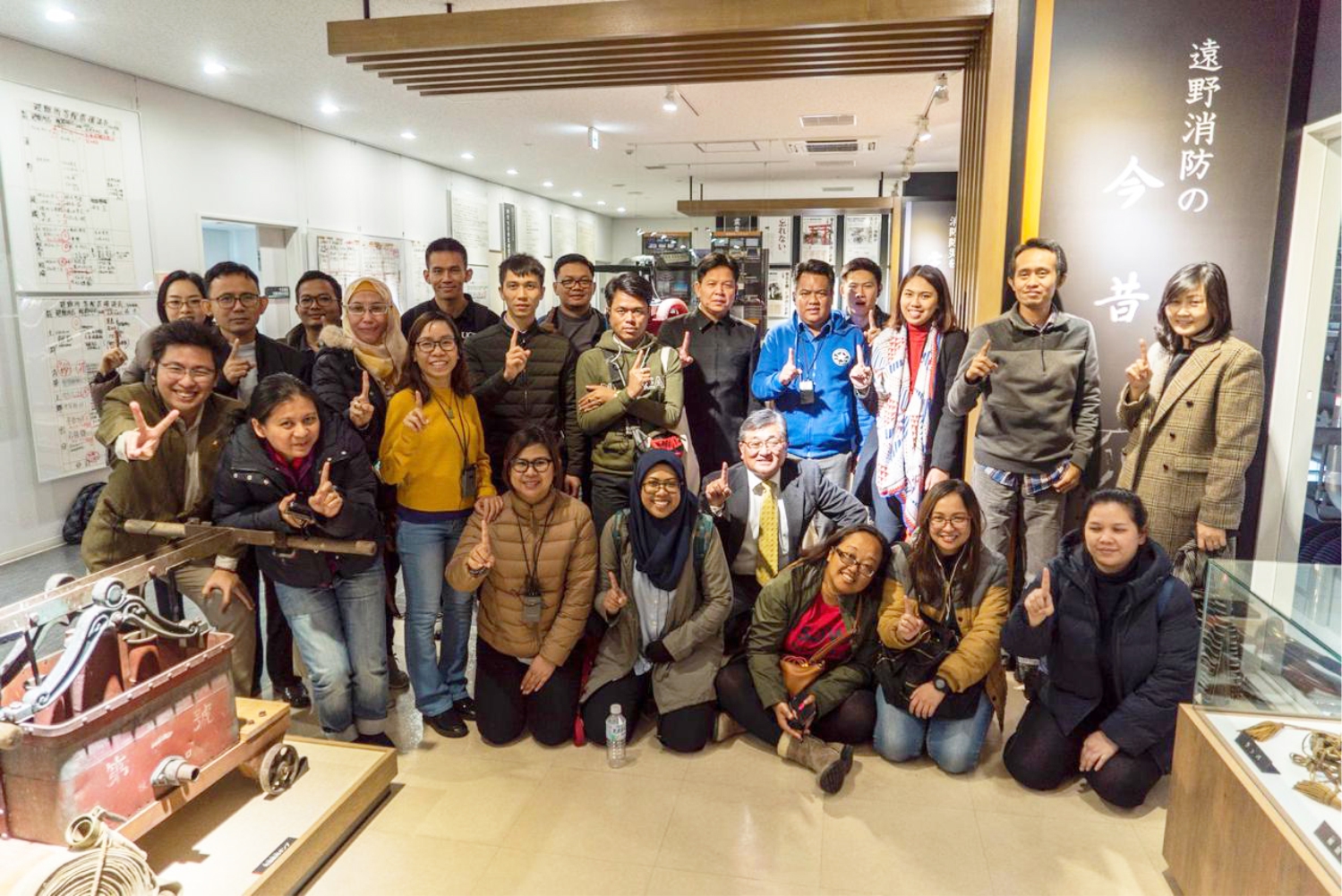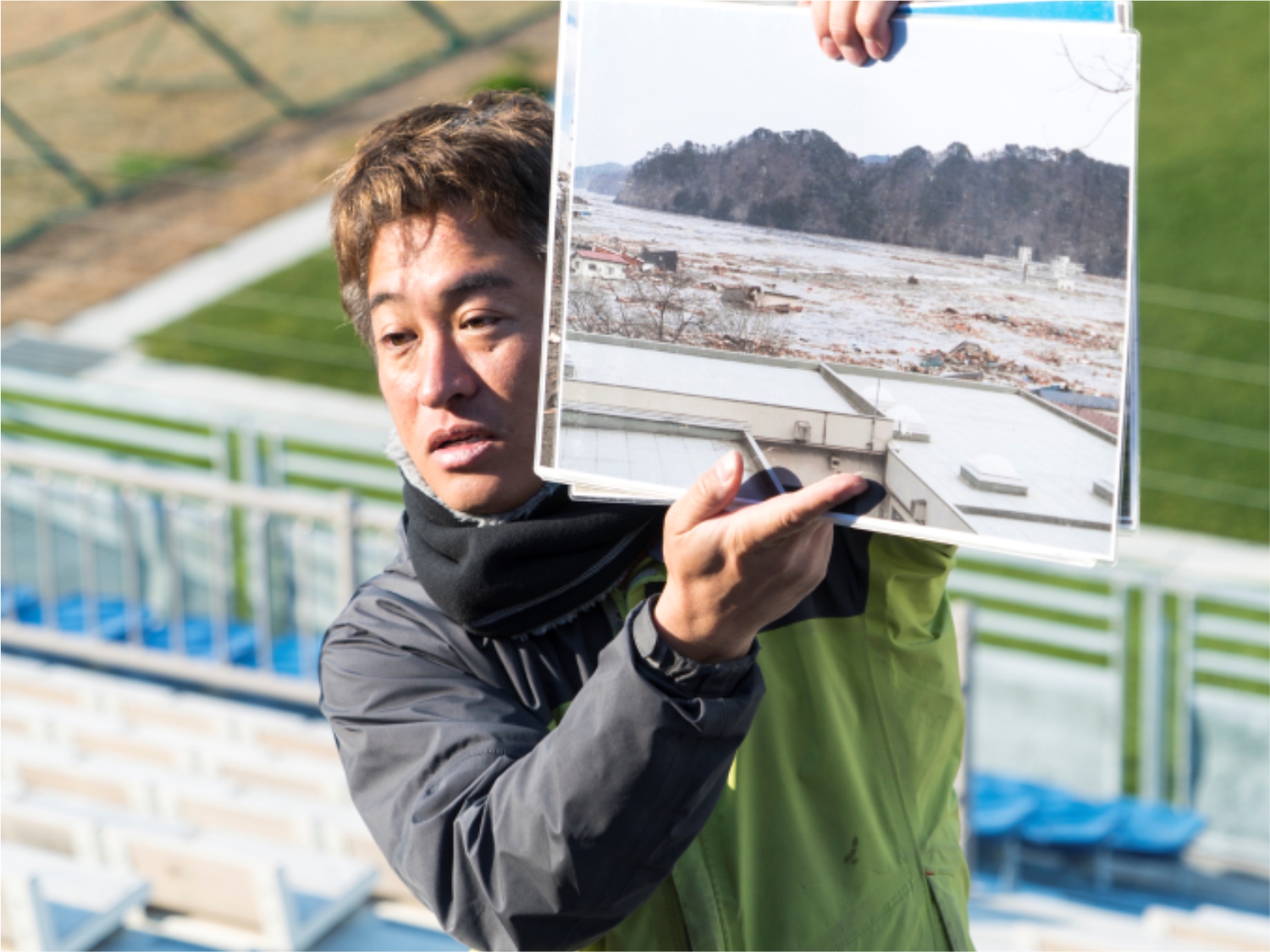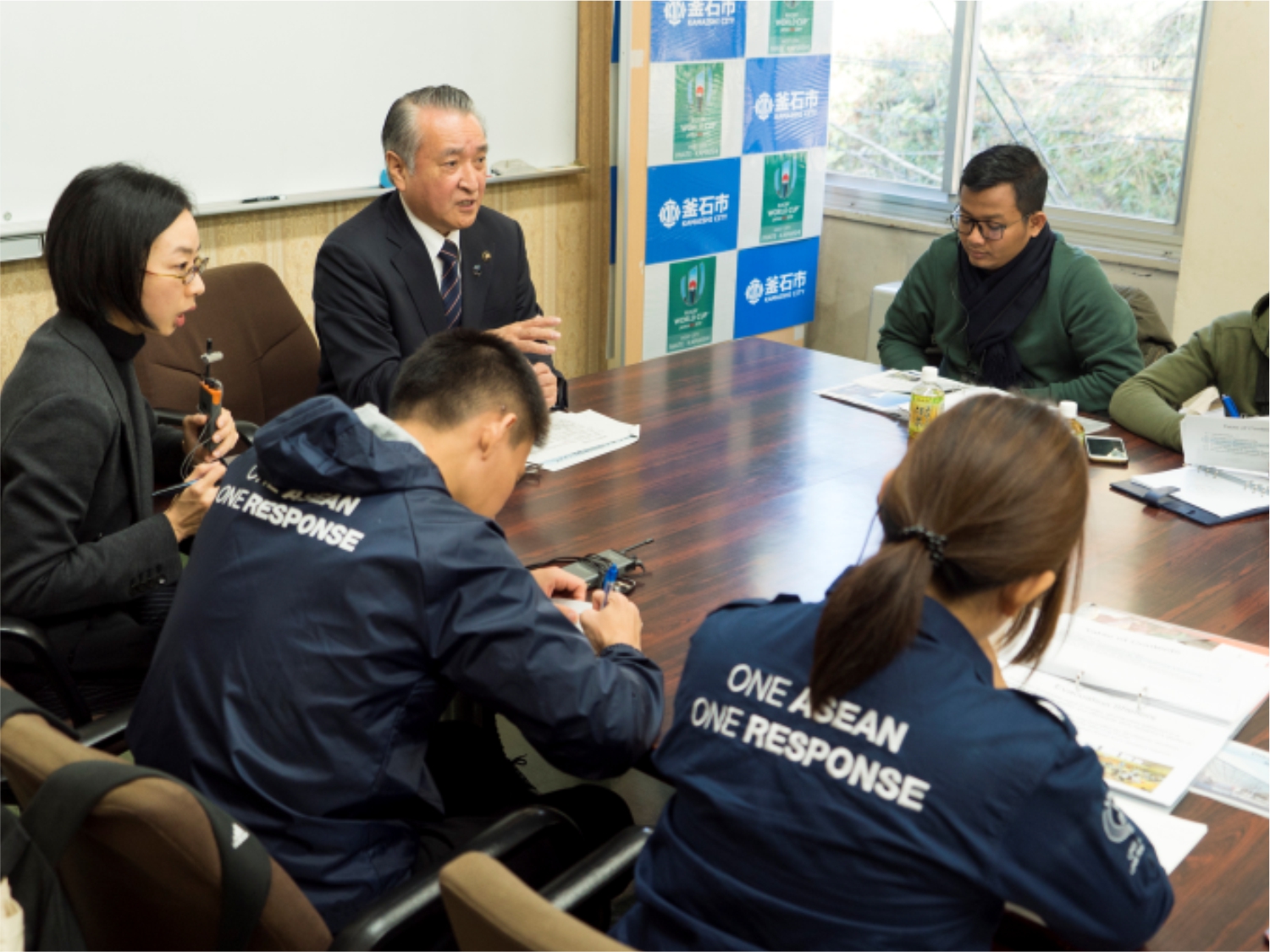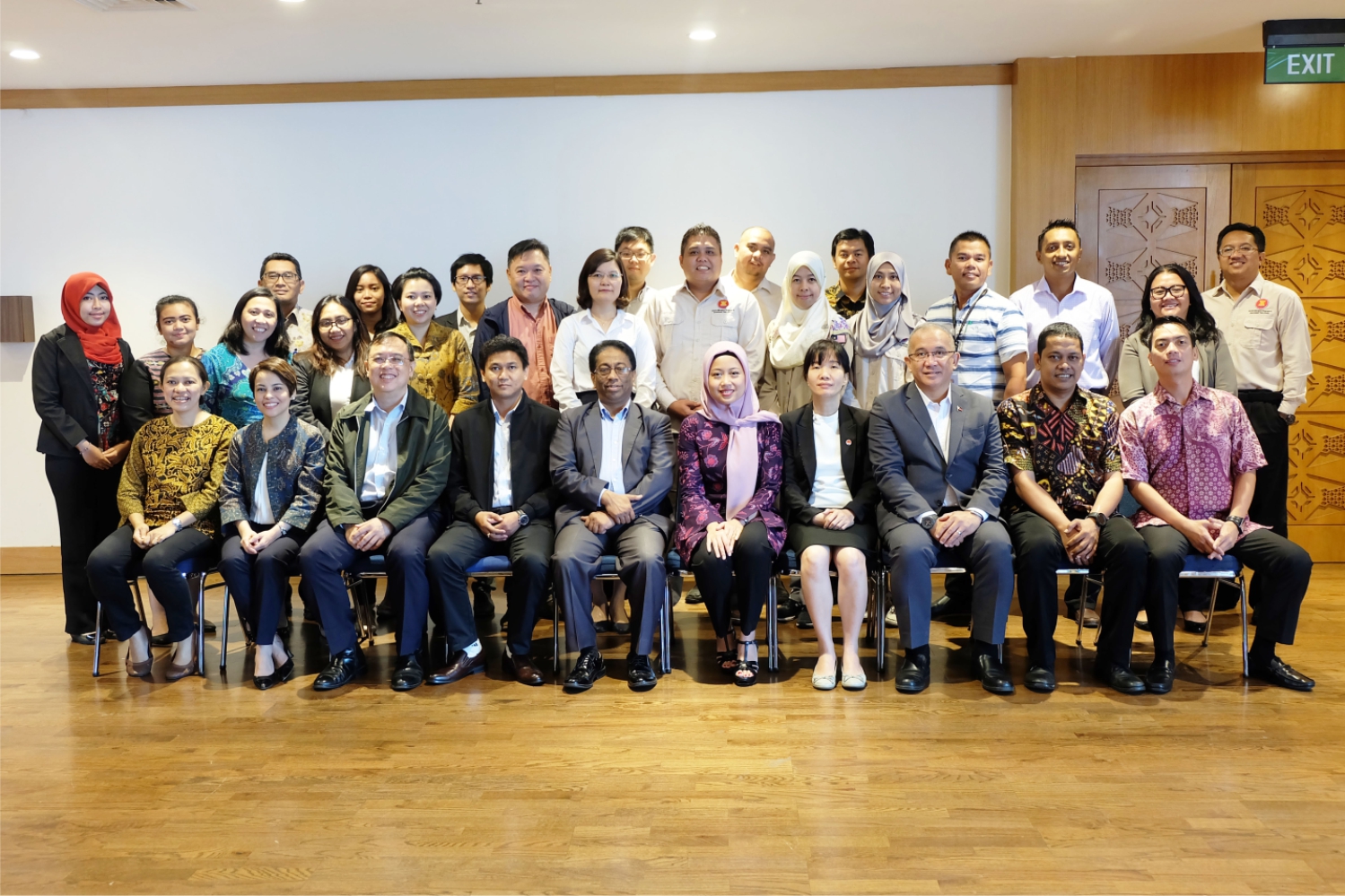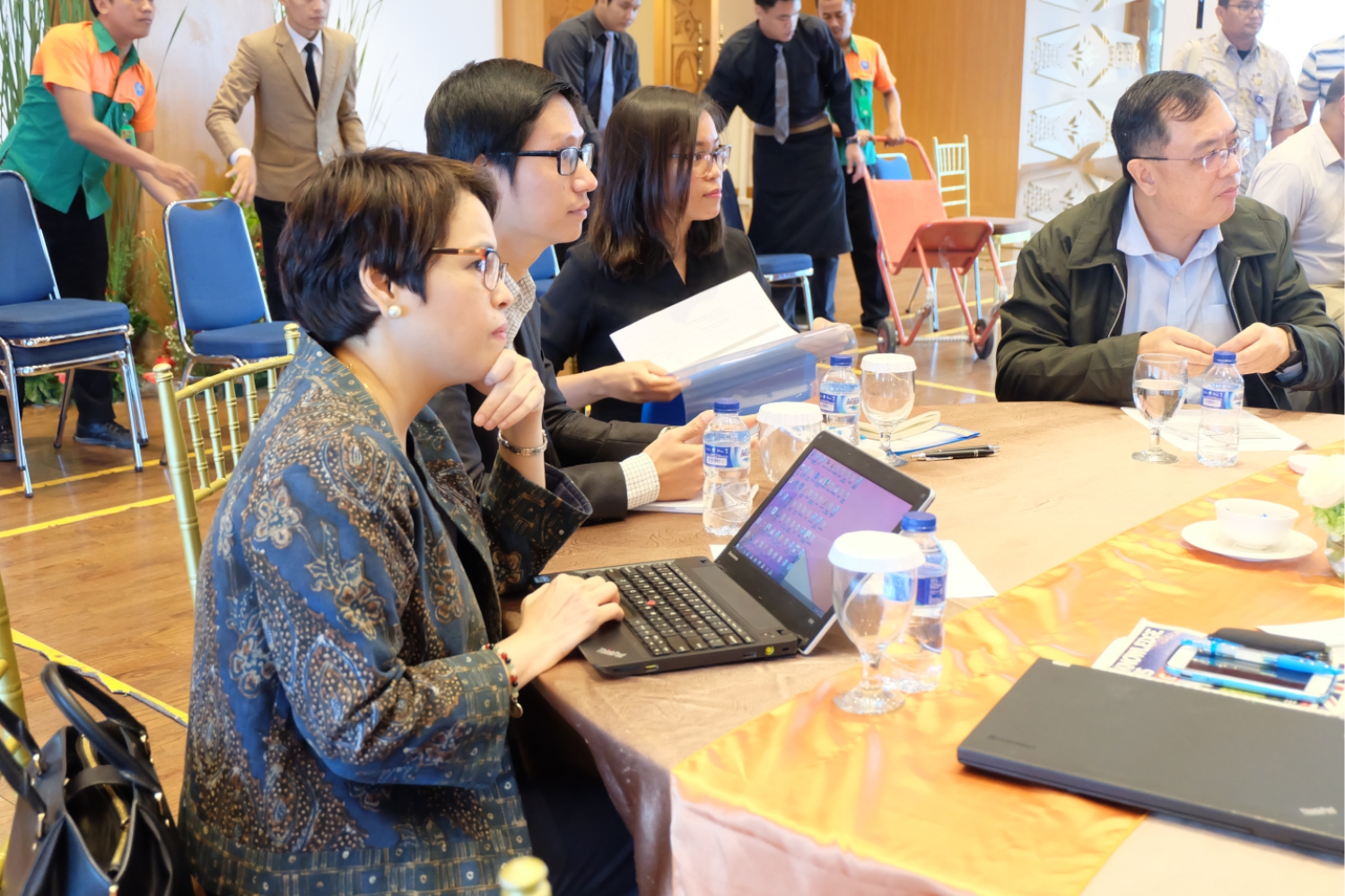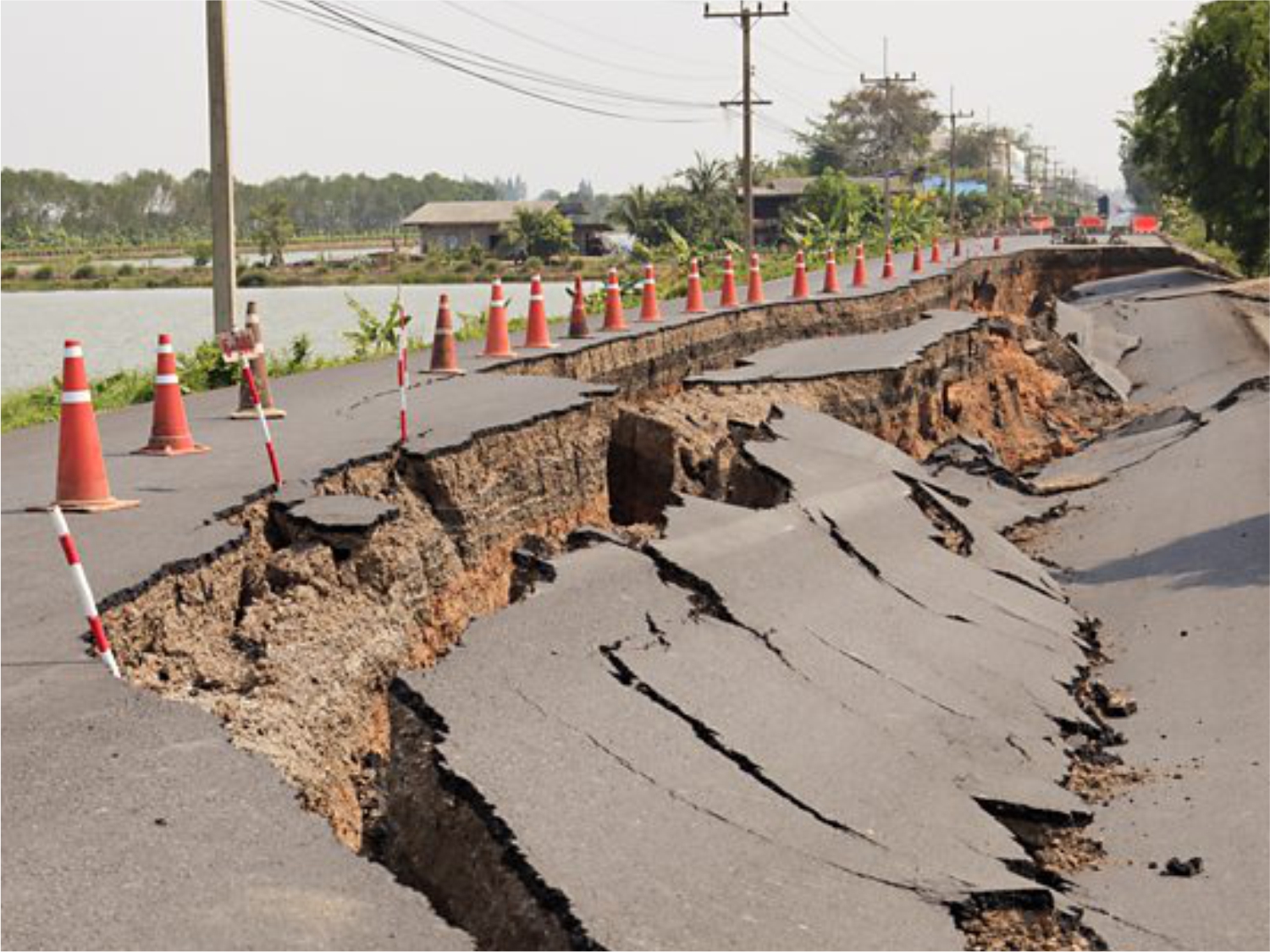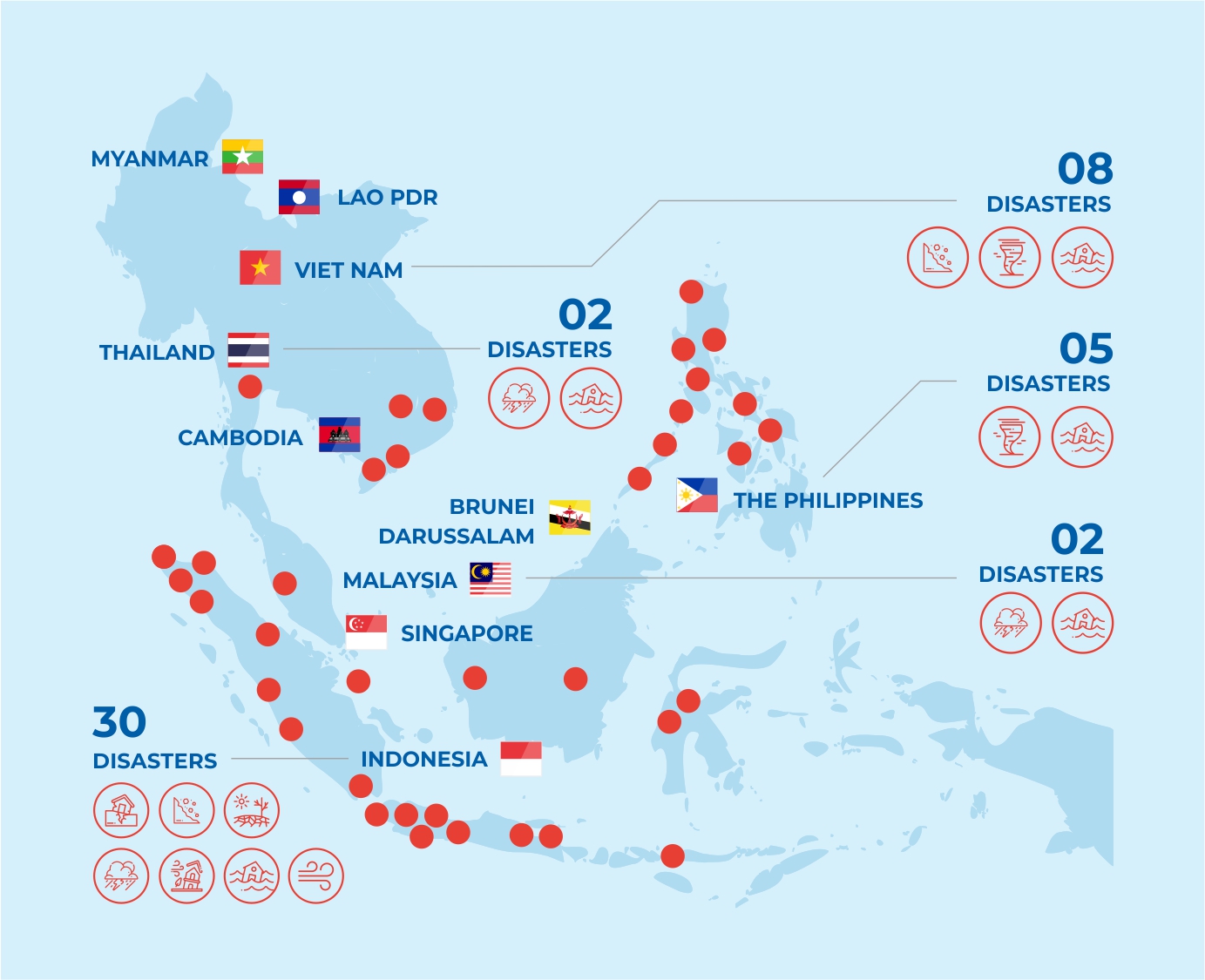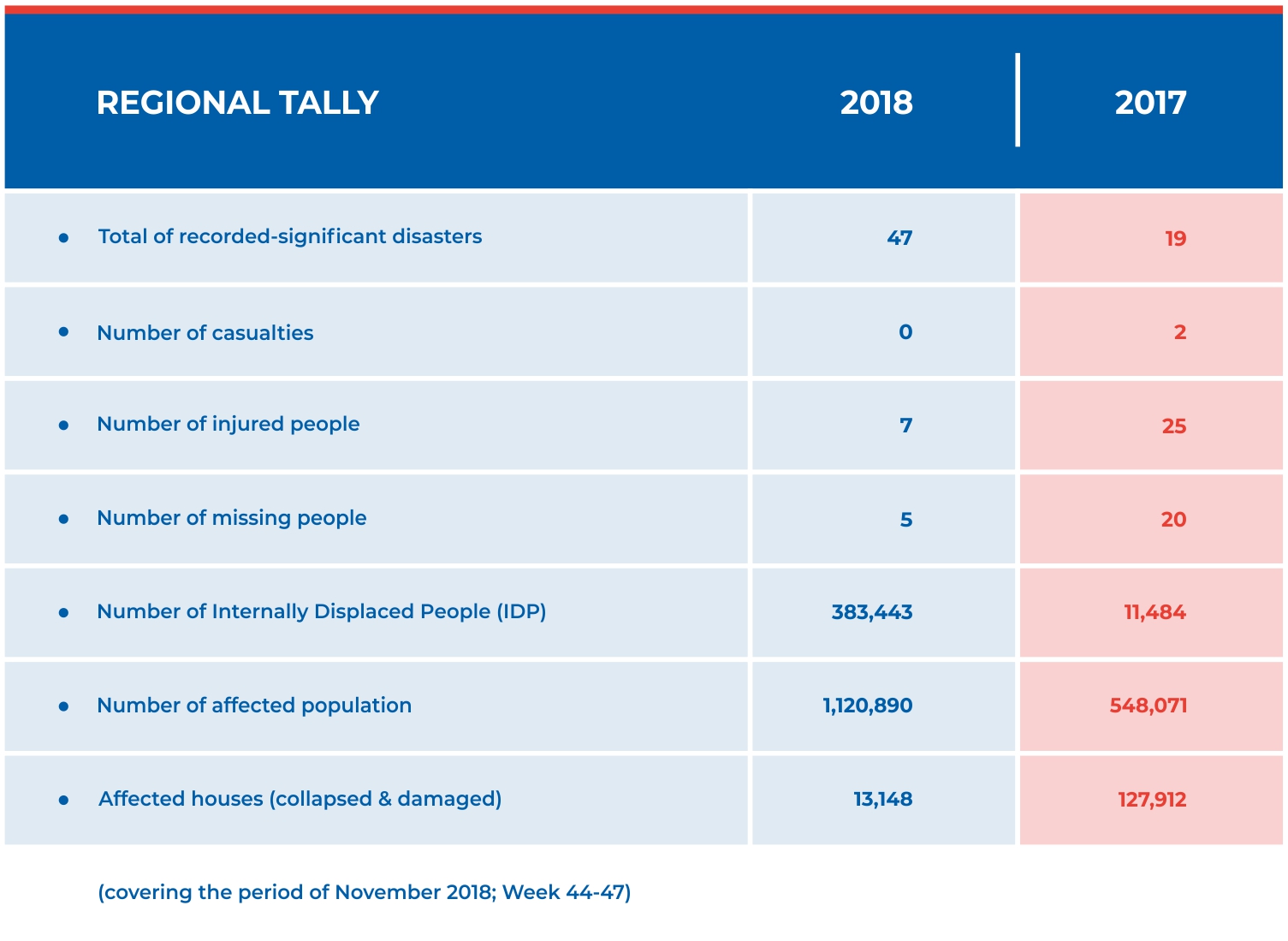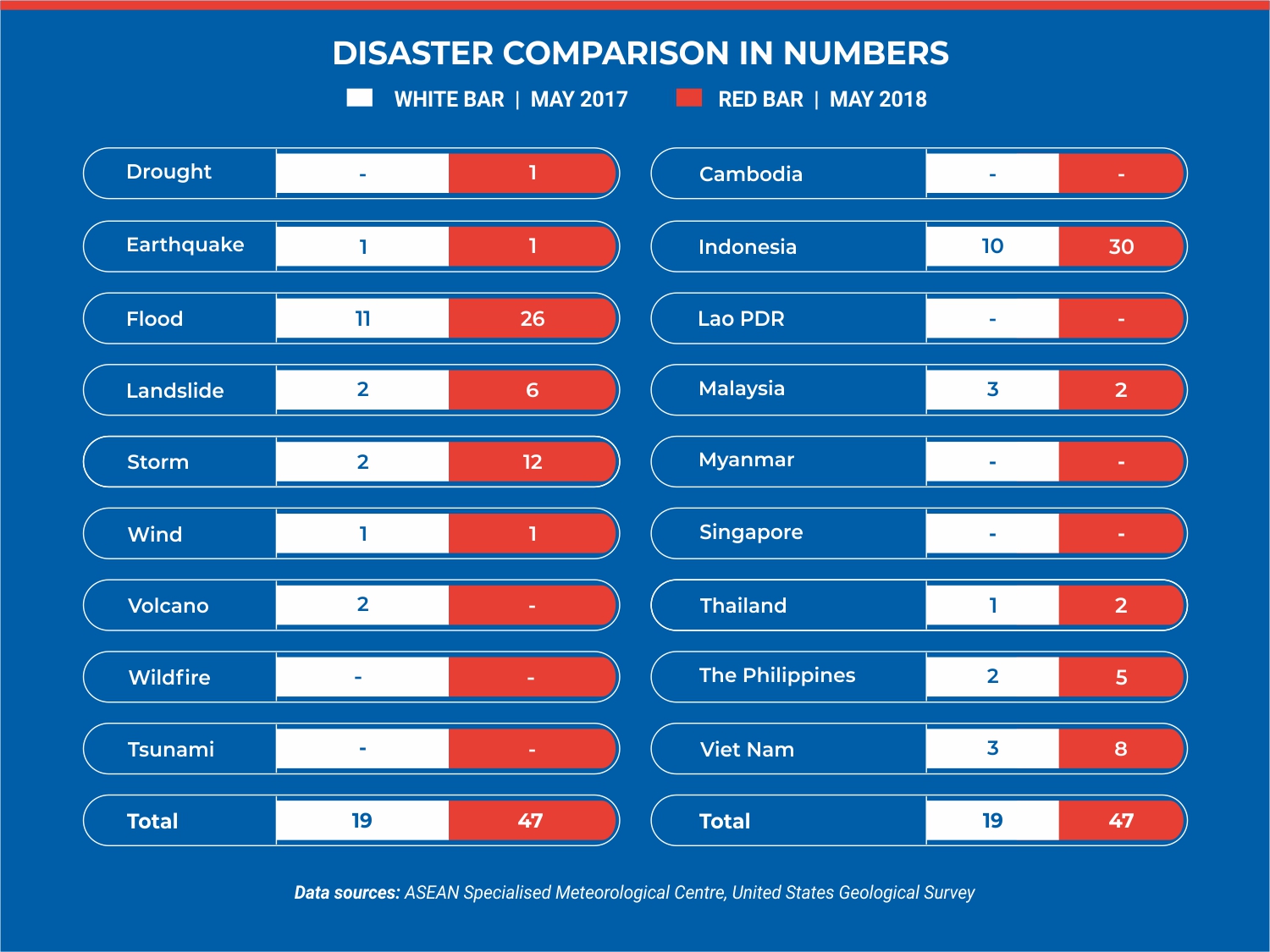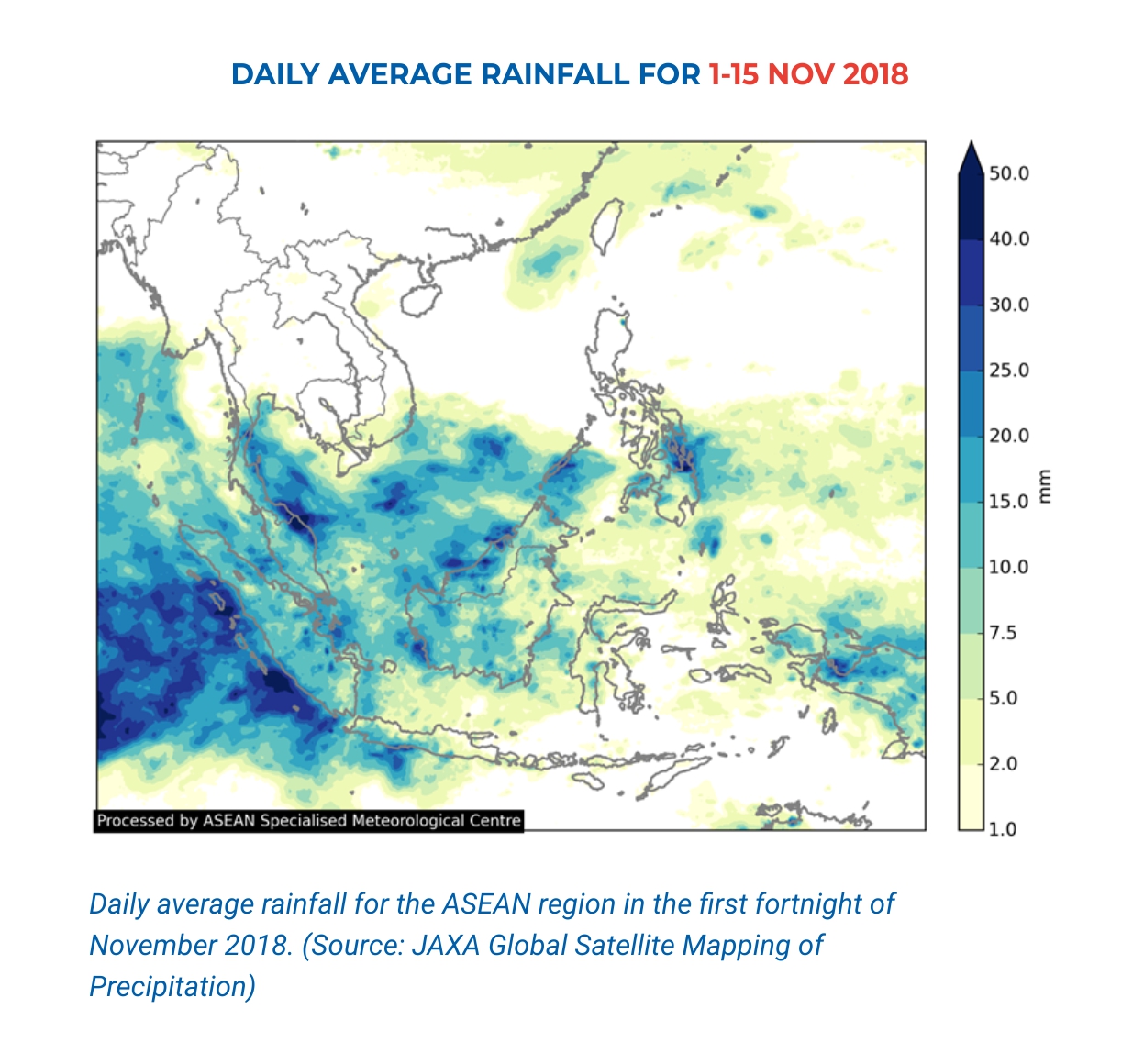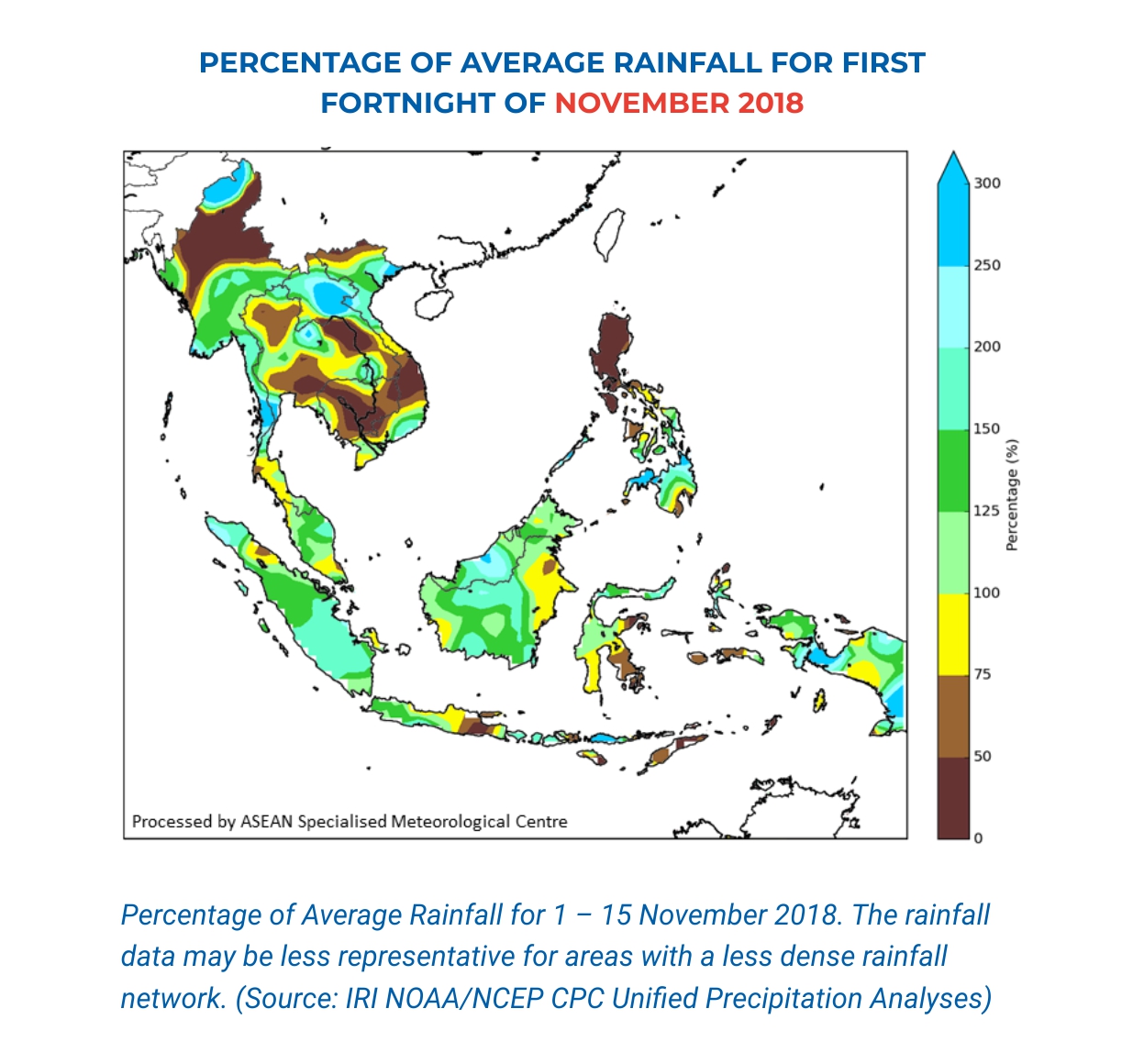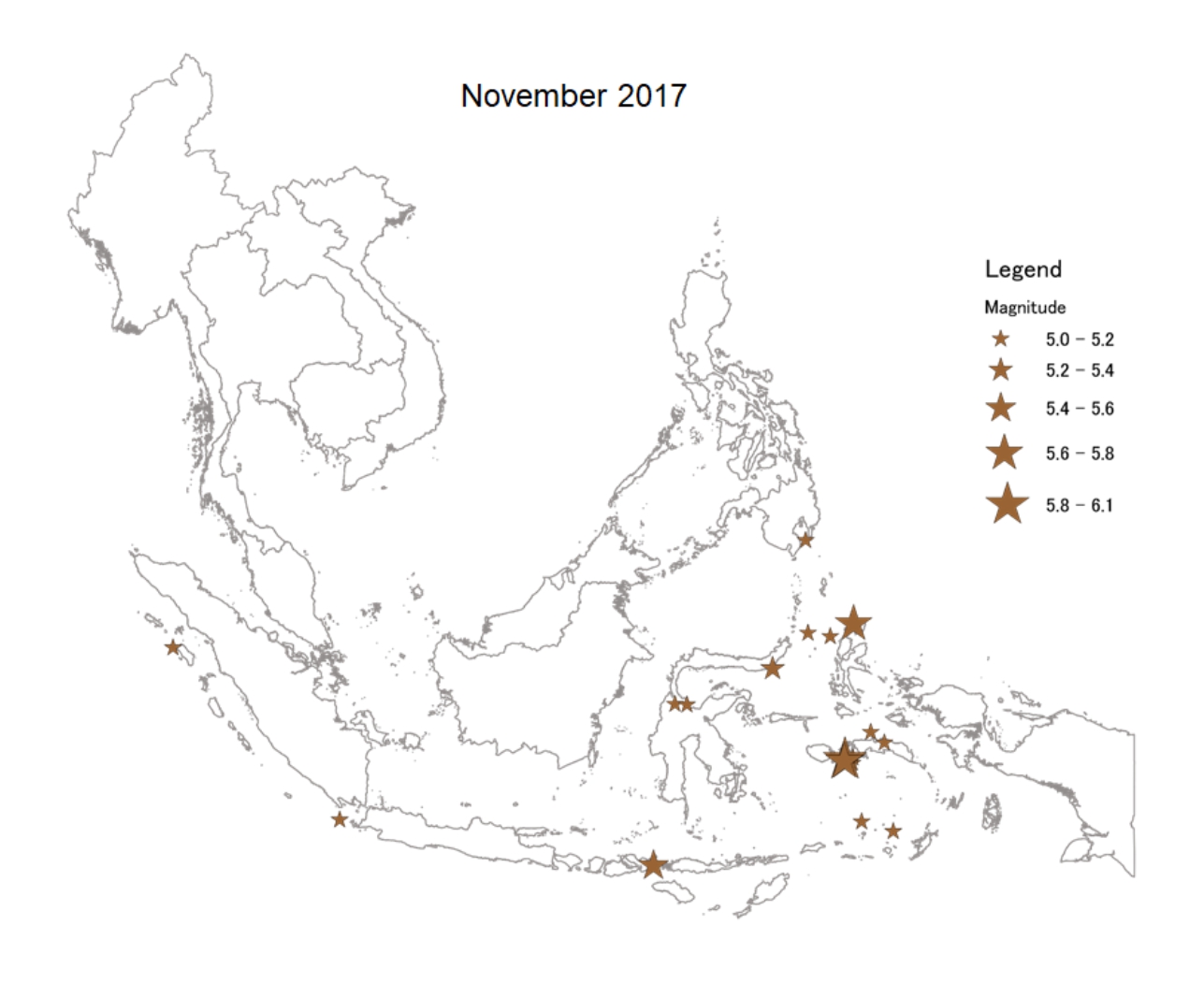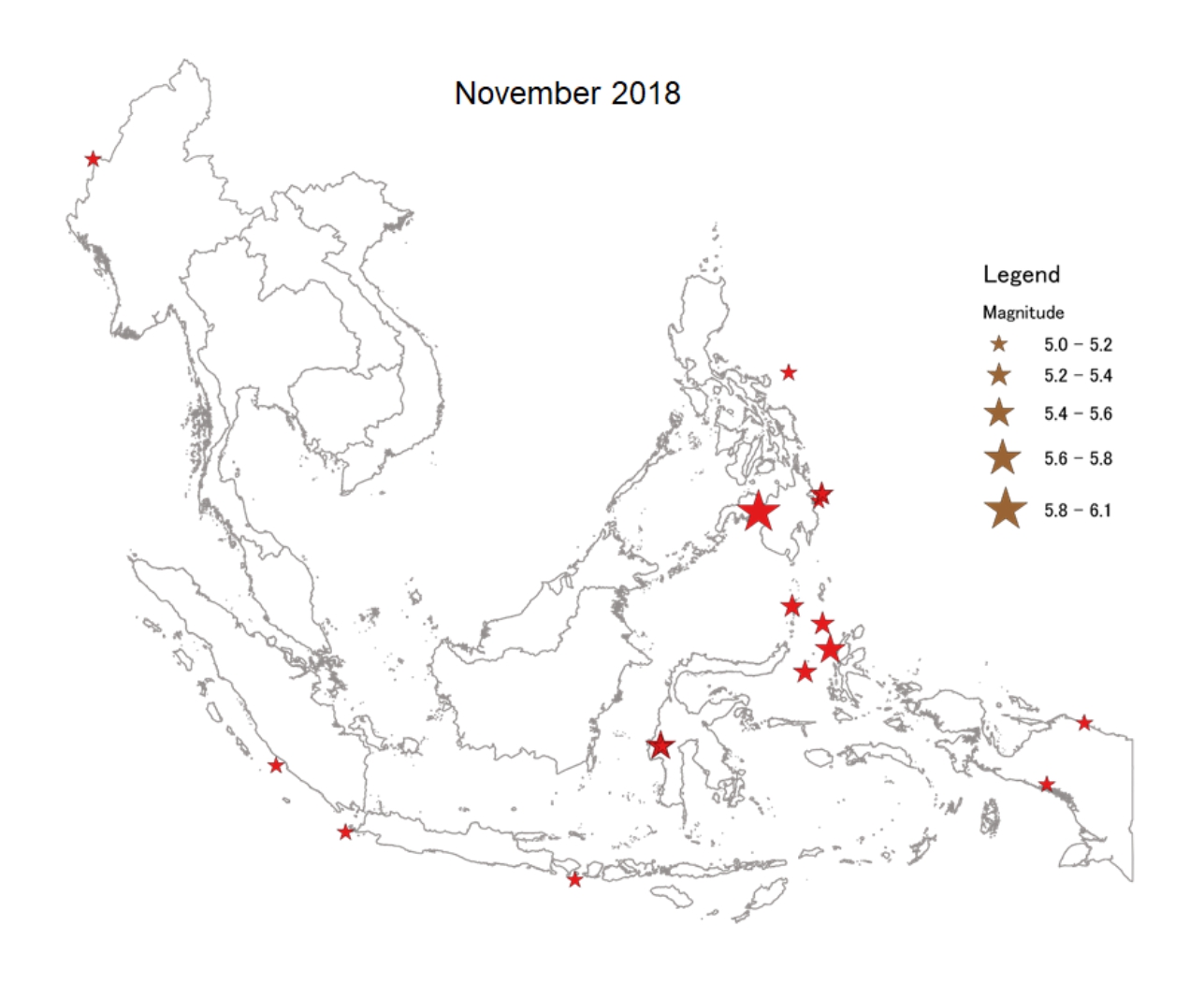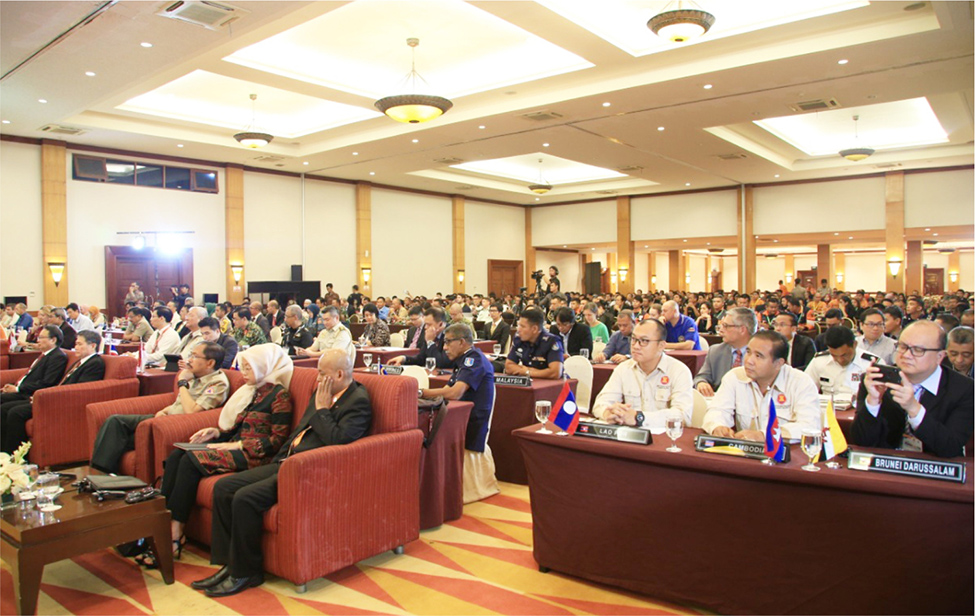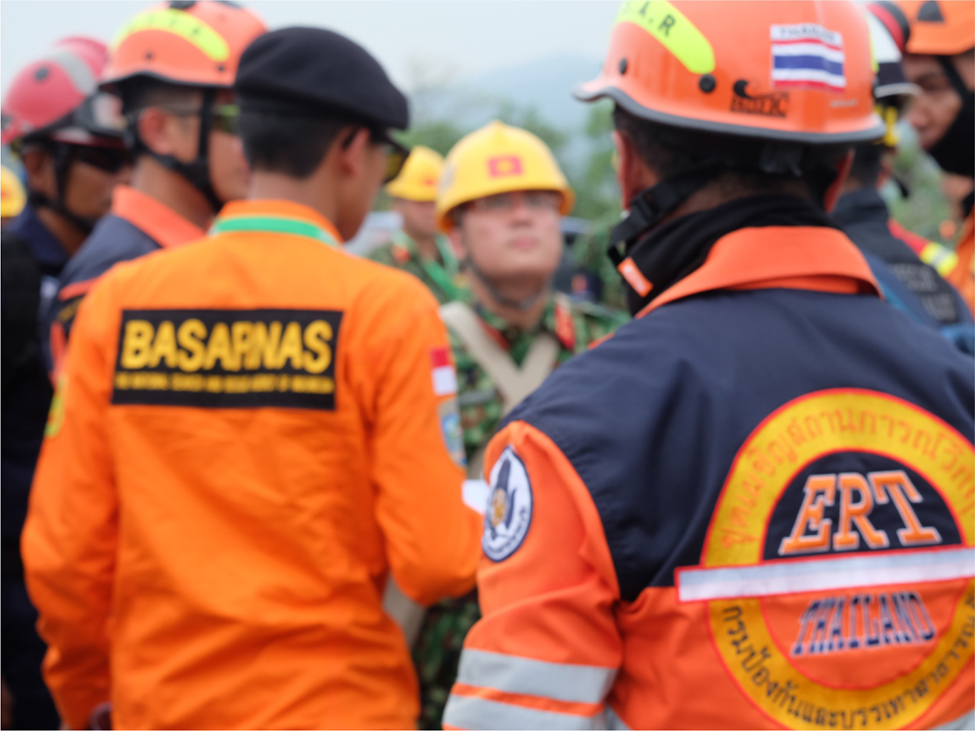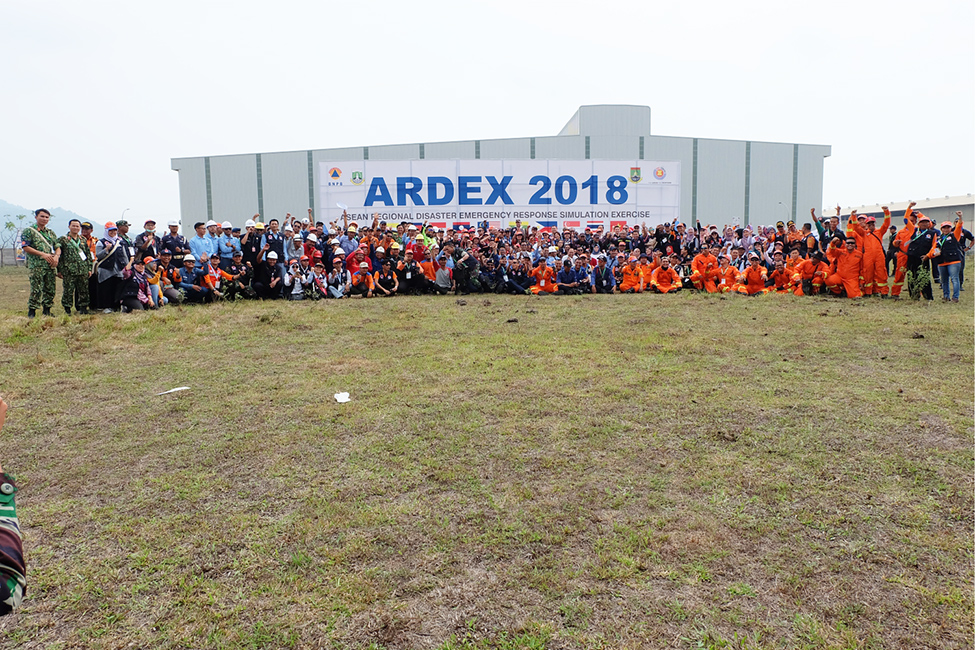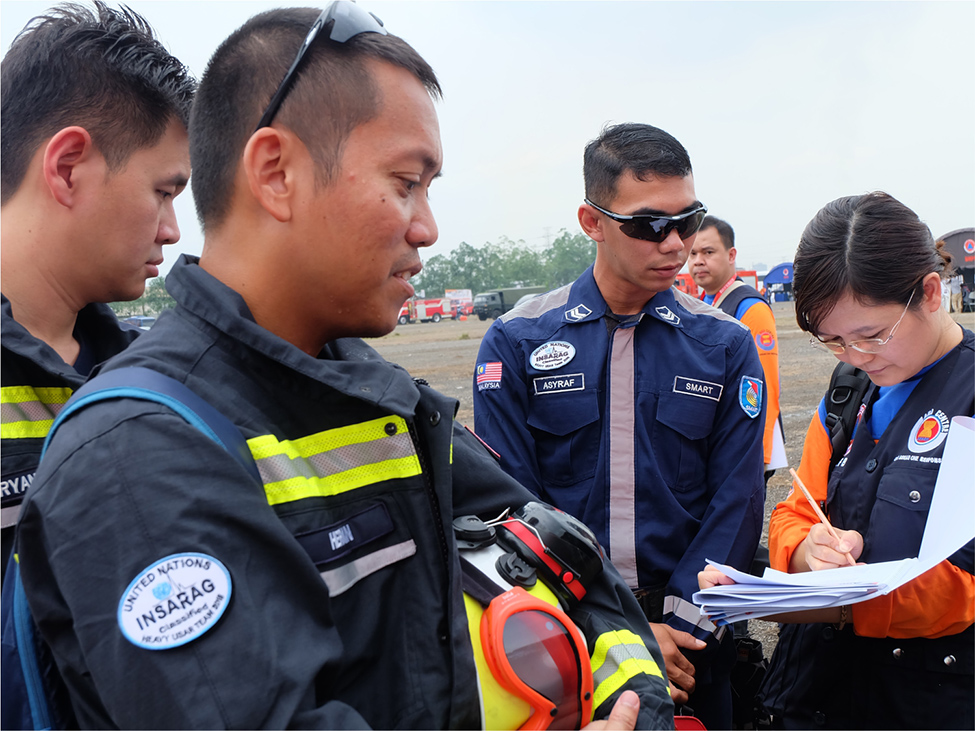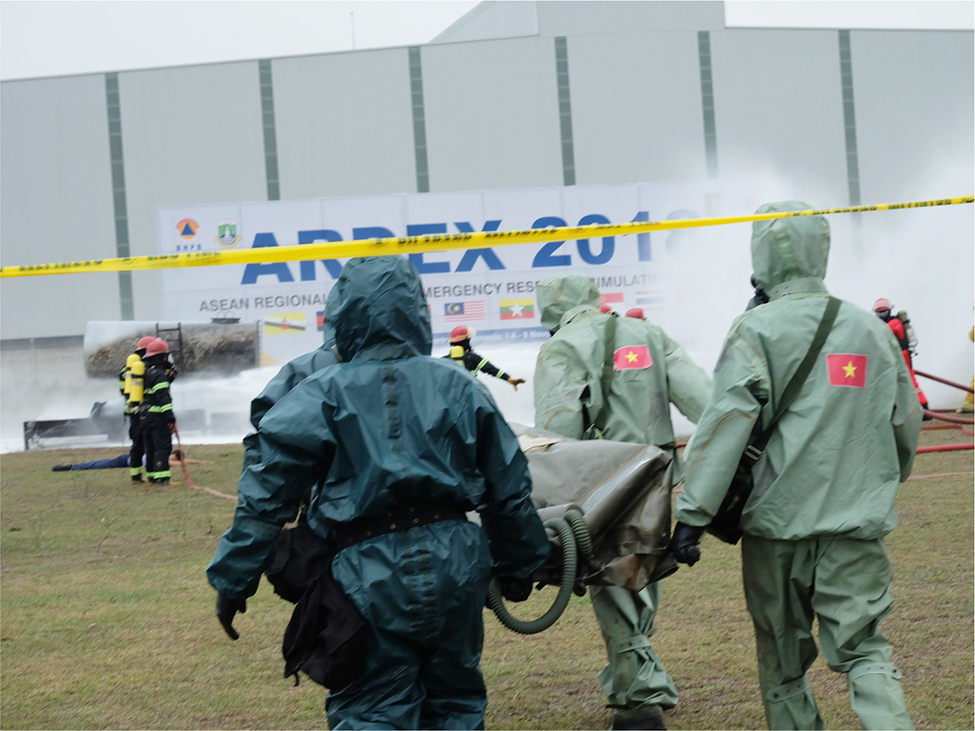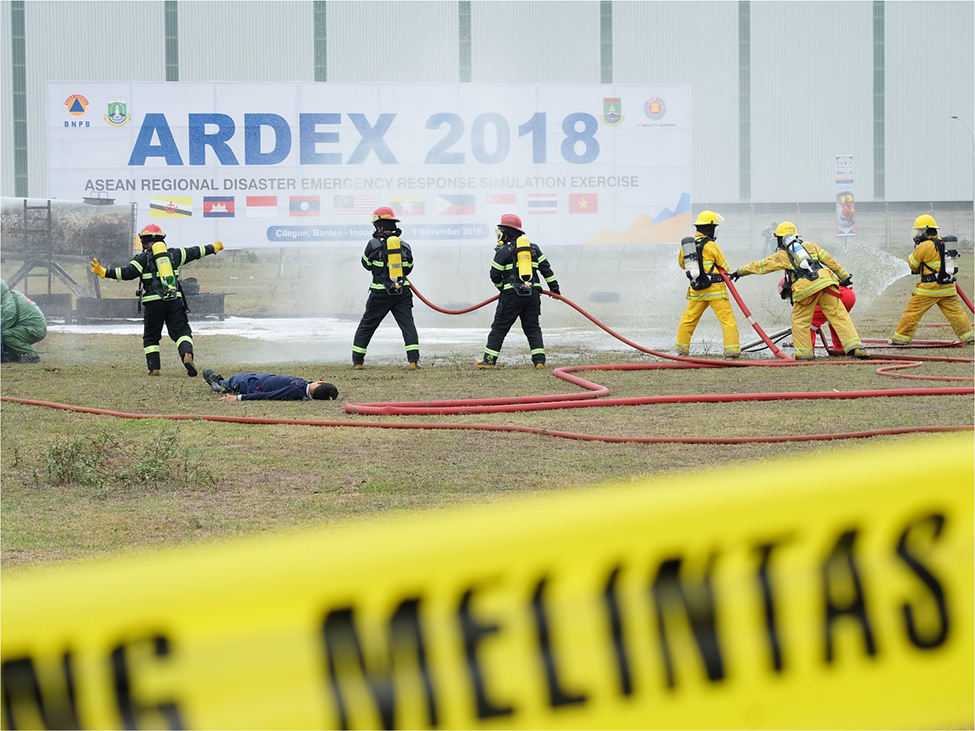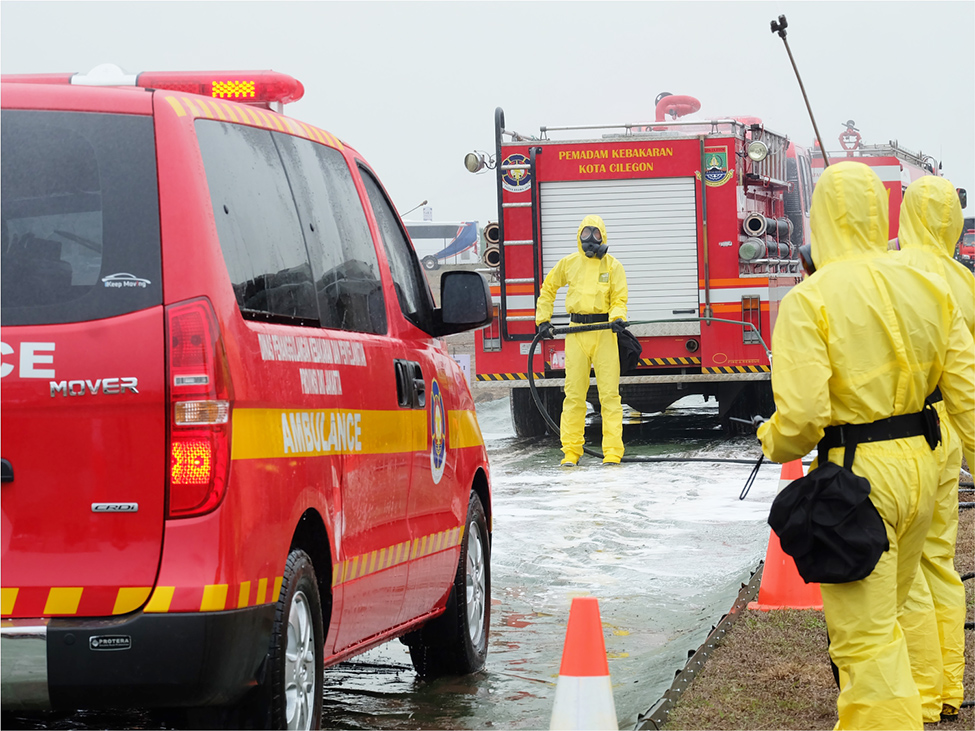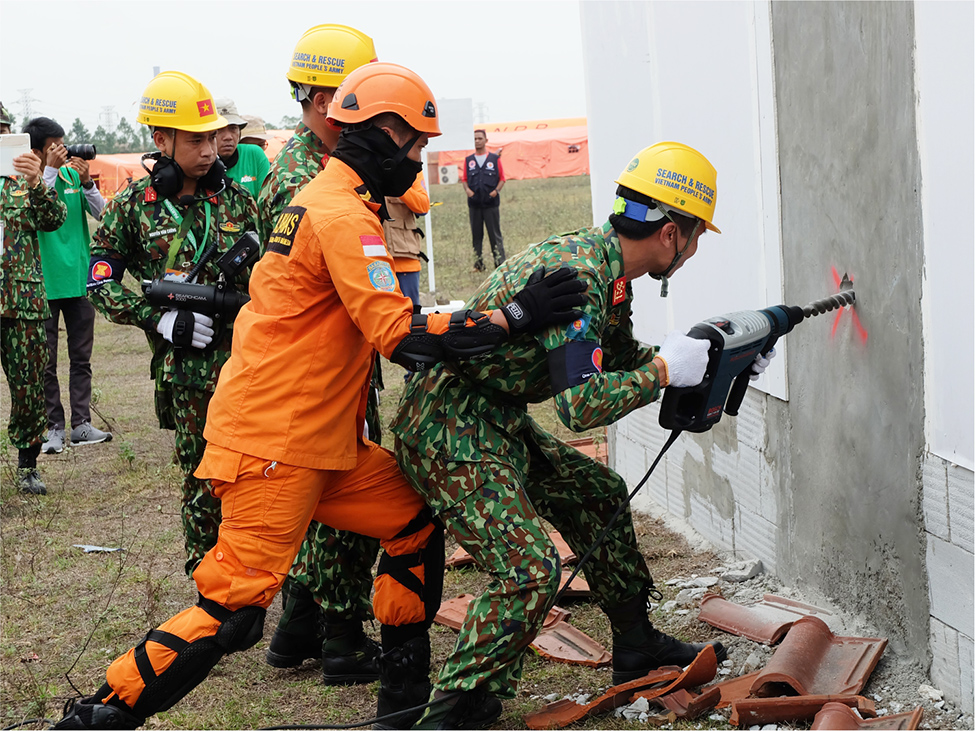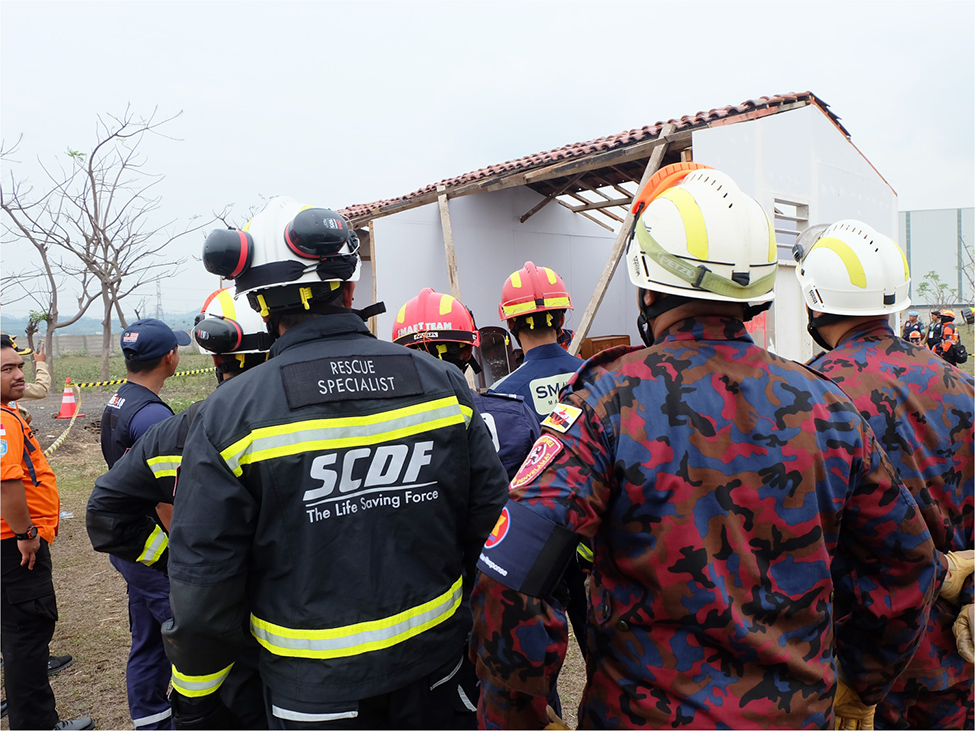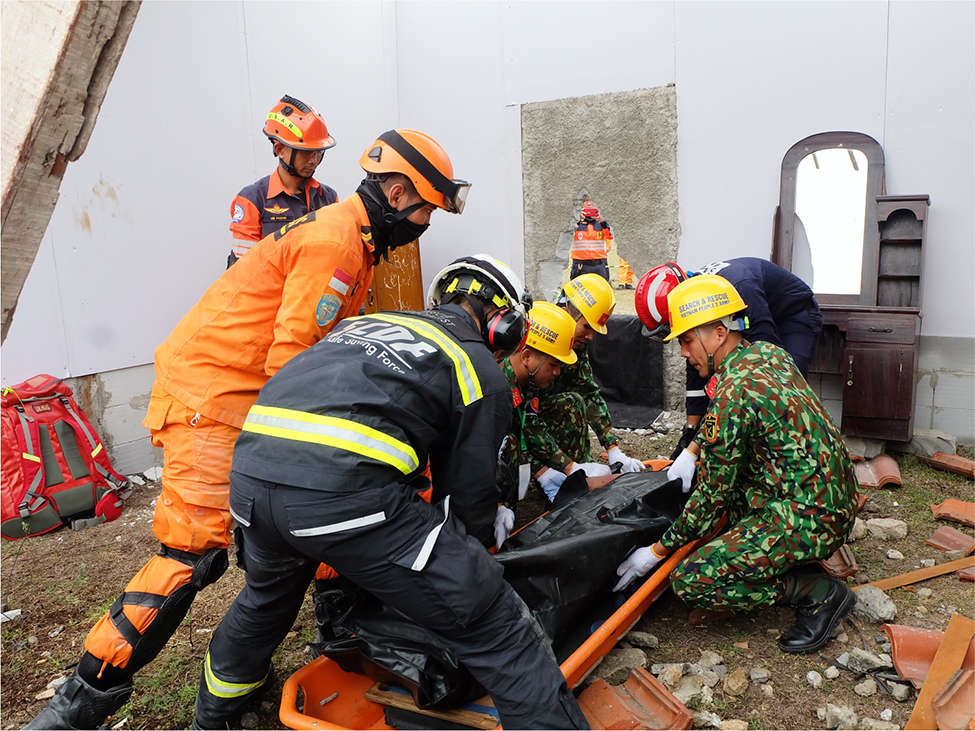Vol 45-MERCY Malaysia

MERCY MALAYSIA
Medical services are an integral element for all phases of ASEAN disaster management – preparedness, response, and recovery. Medical professionals play a vital role in working to safeguard the health and wellbeing of individuals directly and indirectly affected by disaster, as well as aid workers deployed in the field. Importantly, the improvement of the affected population’s psychological health and resilience in order to recover quickly after experiencing a disaster also form a key health-related focus. In the ASEAN region, Mercy Malaysia forms one of the primary organisations for health-related activities in disaster situations, and work alongside the AHA Centre in improving health elements in the ASEAN disaster management field.
MERCY Malaysia, or the Malaysian Medical Relief Society, is an international, non-governmental organisation that focuses on providing medical relief, sustainable health-related development, and risk reduction activities for vulnerable communities, in both crisis and non-crisis situations. MERCY Malaysia is a member of the AADMER Partnership Group (APG), a consortium of seven INGOs who are committed to work with ASEAN to ensure the people-centred implementation of AADMER, leading to a resilient ASEAN region. MERCY Malaysia’s capabilities have also been included by the Government of Malaysia within the ASEAN Standby Arrangements.
MERCY Malaysia has been supporting and contributing in delivering humanitarian aid and expertise to the ASEAN Emergency Response and Assessment Team (ERAT) since 2013. Through this partnership, there will be a greater support, facilitation, involvement, and beneficial participation of civil society organisations from ASEAN Member States. This will be facilitated through a Regional Alliance for Collective Emergency Response (RACER), which allows non-government emergency response organisations to support One Asean One Response. Using the ASEAN Joint Disaster Response Plan (AJDRP), RACER will contribute to the realisation of One ASEAN One Response vision. Furthermore, MERCY Malaysia provides support on developing mental health and psychosocial support (MHPSS) for ASEAN-ERAT members deployed to emergency response situations.
To formalise MERCY Malaysia’s engagement with the AHA Centre, the two organisations signed a Memorandum of Intent (MoI) on the 27th of June, 2018, in Kuala Lumpur, Malaysia, on the sidelines of the Eighth Meeting of the Governing Board of the AHA Centre. The MoI not only strengthens the partnership between the two entities, but also signifies their commitment to cooperate in areas of mutual interest, and to reinforce each party’s current capacities that are recognised as mutually beneficial.
Written by : William Shea | Photo : MERCY Malaysia
- Published in Partnership
Vol 45-ACE Programme Photo Diary November

ACE PROGRAMME PHOTO DIARY NOVEMBER
November 2018 saw participants of the AHA Centre’s Executive Programme (ACE) undertake a range of new and innovative workshops and presentations, alongside engaging on another valuable study trip – this time to one of the leading countries in disaster management, Japan.
The month began with training sessions at the AHA Centre, focused on emergency communications and report writing. Following this, participants were provided an in-depth training on the all-important area of Civil-Military Coordination, which was developed and provided by representatives from the United Nations Office for the Coordination of Humanitarian Affairs (UNOCHA) and the Australian Civil Military Centre (ACMC). Finally, for the last two weeks of November, participants departed to Japan to embark on an array of trainings, presentations and visits to some of the nation’s leading disaster management bodies, alongside locations of disasters previously faced by Japan and its people. The value and insight that participants can gain from Japan’s experience and knowledge is hoped to help form a benchmark for the work of ACE Programme graduates into the future.
WEEK-1
ACE participants engage in key training regarding Emergency Communications, facilitated by the AHA Centre’s Communications Officer Ms. Shintya Kurniawan, and Mr. Vivian Lines, one of the region’s leading Public Relations experts on Crisis Communications. Participants learned to develop key messages, and practice for ambush interviews by media, which are often part of the ASEAN-ERAT emergency simulation exercises, as well as actual emergency responses.
WEEK-2
Civil-Military coordination forms a cornerstone of disaster management practices, and ACE participants delved into this complex and interesting topic with trainings from UNOCHA’s Regional Office for Asia and the Pacific (UNOCHA-ROAP) and the ACMC. Facilitators included Ms. Silke Banuelos Kuang (UNOCHA- ROAP), Mr. Nidhirat Srisirirojanakorn (UNOCHA- ROAP), Dr. Kristie Barrow (Director of International and Domestic Engagements of ACMC), Mr. Mark Harvey (Defence Delegation of the Embassy of Australia) and Ms. Agustina Tnunay (AHA Centre).
WEEK-3
Upon arriving in Japan, participants engaged in visits and talks with representatives from the Japanese Ministry of Foreign Affairs, visited a number of key emergency management sites in Tokyo, including the Japan Platform (JPF) and Tokyo Rinkai Disaster Prevention Centre, as well as engaging on a visit to the United Nations University (UNU). They learned and shared insights with leaders of Japanese disaster management including, amongst others, Mr. Nicholas Turner and Dr. Riyanti Djalante (Institute for the Advanced Study of Sustainability at UNU), Ms. Yuko Shibata (General Manager of Emergency Response Division at JPF), and Mr. Tada (Executive Director, Tono Magokoro Net).
WEEK-4
Participants toured some of Japan’s major disaster sites, including areas impacted by the 2011 tsunami around Kamaishi City, learning about the disaster and rebuilding experiences from the Kamaishi City Mayor, Mr Takenori Noda. They visited a number of tsunami-impacted areas around Kamaishi City, and were offered the chance to learn directly from some of the disaster’s survivors, before making their way back to Tokyo. To finish up the 10-day study experience, ACE Programme participants met staff and representatives from the Japan International Cooperation Agency – one of the biggest supporters of the ASEAN region’s disaster management efforts.
Written by : Ferosa Arsadita | Photo : AHA Centre
- Published in AHA Centre Diary 2
Vol 45-AHA CENTRE Disaster Response After Action Review

AHA CENTRE DISASTER RESPONSE AFTER ACTION REVIEW
With a total of seven disaster responses undertaken during 2018, the AHA Centre’s team, its Governing Board members from the ASEAN countries, and a number of its partners embarked on a comprehensive After-Action Review (AAR) of all responses, from the 26th to the 28th of November in Jakarta. This AAR covered a large range of areas relating to 2018’s responses – highlighting strengths and improvements, discussing weaknesses and areas for development, as well as gaining a range of inputs from all participants to support the strengthening of ASEAN’s disaster response efforts into 2019 and beyond.
Much of the 3-day discussions focused on ASEAN and the AHA Centre’s interoperability with the ASEAN Secretariat, NDMOs, the United Nations and other humanitarian partners, in the ongoing effort to ensure all parties can work efficiently and fluently side-by-side for the betterment of the ASEAN region. A key outcome was the agreement that there should be continuing increase in the numbers of ASEAN stakeholders engaged in ASEAN processes. Although many ASEAN bodies who specifically focus towards disaster management (such as NDMOs) are familiar and engaged with the AHA Centre, it was highlighted that other key sectors such as military and related ministries need to be more involved with ASEAN disaster management mechanisms, in order to truly realise the One ASEAN One Response vision.
The first day of the review was focused towards internal discussions for the AHA Centre itself, with all staff and management involved in disaster responses engaging on this internal review. Following the internal reflections, the AHA Centre opened the floor to their working partners from the region and local governments who form a key part of the AHA Centre’s work. Input was sought from the AHA Centre’s Governing Board, staff from National Disaster Management Organisations (NDMOs), as well as the ASEAN Secretariat – particularly staff engaged as ASEAN-ERAT responders who provided support to the AHA Centre Emergency Operations Centre during response periods. Finally, the AHA Centre spread its quest for input further again, inviting a range of partners engaged in the humanitarian response, such as the ASEAN Dialogue Partners, United Nations, and the Red Cross and Red Crescent Movement.
Written by : Shintya Kurniawan | Photo : AHA Centre
- Published in AHA Centre Diary 1
Vol 45-Deconstructing Myths About Natural Disasters

DECONSTRUCTING MYTHS ABOUT
NATURAL DISASTERS
There were many myths about natural disasters before science reached its current point, and also the possibility of misinterpreting science, and other elements surrounding a hazard or disaster. While some myths may be interesting and a great topic for dinner conversations, it is better for science to guide our actions when preparing for or experiencing a natural disaster. The following are a range of myths we often hear – particularly during times of heightened disaster activity – that have been comprehensively ‘busted’ by increases in human understanding and the science of natural disasters.
MYTH #1
OPENING YOUR WINDOWS DURING A TYPHOON WILL STOP YOUR BUILDING FROM EXPLODING.
It was once widely believed that opening top windows in a home would release pressure during a typhoon, to ensure that a building would be safe from explosion due to high pressure build-up. However, with improvements to science and understanding of physics and engineering, it has been categorically found that this act does not support your home during a typhoon – in fact it adds to the likelihood of your roof being blown off due to wind entering your home and pushing upwards. This, alongside constant battering from the wind outside, would lift the roofs of houses making it look like they had exploded due to pressure from the inside. This myth is further from the truth due to the fact that houses are not airtight in their general state, have no vacuum, and therefore cannot form a pressure differential. In the face of a typhoon, it remains best to secure all windows and doors, turn off appliances and gas lines, and seek shelter a small interior room, closet or hallway on the lowest level of your home if you have not been able to evacuate the area.
MYTH #2
DOGS AND OTHER ANIMALS CAN “SENSE” WHEN AN EARTHQUAKE IS GOING TO STRIKE.
For centuries there have been stories and accounts of strange animal reactions in the lead-up to an earthquake, and while these are intriguing, there are no particular scientific links between an animal’s ‘sixth sense’ and an impending earthquake. There is room for thought on animals sending pre-shocks that preceded a larger quake, however this again is merely a concept for an interesting discussion or storytelling session. In reality, what animals sense, if they feel anything at all, remains a mystery. Earthquakes are a sudden phenomenon, and seismologists have no way of knowing exactly when or where the next one will strike. While there have been various research projects undertaken to link animal sensory behaviour with earthquakes, many outcomes are based on varying hypothesis, and also based on retrospection and memory after an earthquake event (due to the above fact that earthquakes are unpredictable). Overall, there is no strong evidence supporting this – and while this might be an interesting theory, it is still best to follow the warnings and guidance of your local disaster management authority and be prepared for an earthquake event at all times.
MYTH #3
LOTS OF SMALLER EARTHQUAKES KEEP BIGGER ONES FROM HAPPENING.
It may feel that the onset of small earthquakes forms some sort of ‘tension release’, that ultimately decrease the size and scale of a larger earthquake – however this is untrue. Small quakes do in fact relieve stress on a fault line, but in reality it is way too little stress to decrease the likelihood of a larger quake. Earthquake monitoring shows that around a single 6M earthquake there can be hundreds, even thousands of smaller earthquake events (before and after a large event), however none of these serve to decrease the magnitude of the largest quake. In reality, these smaller quakes only serve to evidence that the fault line is in the midst of activity, and should make us consider our preparedness and readiness for the onset of a larger quake.
MYTH #4
HOLDING ONTO A SOLID OBJECT WILL HELP YOU SURVIVE A TSUNAMI.
While there are some amazing stories of survival, the reality is that most people do not survive being swept away by a tsunami. The power, amount and height of the water surge is much too strong for most ‘immoveable’ objects, let alone for anyone unfortunate enough to be hanging onto them. The best way to avoid being caught by a tsunami is to be aware of your location, including tsunami evacuation routes, should a strong coastal earthquake occur. If this happens, follow the guidance of local authorities and evacuate if requested, and should you find yourself with limited time before the tsunami strikes, quickly find shelter on higher ground nearby.
MYTH #5
YOU CAN OUTRUN A TORNADO IN A VEHICLE.
While some vehicles may have higher speeds than the average 60-120km/h winds created by tornadoes, you would have to be a very lucky person (or racing car driver) to outrun one in your vehicle. Tornadoes turn and flip vehicles with ease, ensuring that you and any passengers would be in the greatest of danger. Alongside the varying windspeeds, the idea also must factor-in changes in wind direction, as well as the array of obstacles and flying debris that would cross your path. Therefore, if you have not had the chance to evacuate from the path of a tornado, it is best to avoid windows and take shelter in a basement or a window-less middle room on the lowest level of a building.
MYTH #6
IF ONE MOUNTAIN IS INCREASINGLY ACTIVE OR ERUPTS, IT WILL TRIGGER ERUPTIONS IN OTHER NEARBY VOLCANOES.
While many volcanoes may be situated along a single fault line that is experiencing increased activity, there is no link between a mountain’s eruption and the state of others nearby. In reality, each volcano has a ‘life of its own’, with its own characteristics, activity, pressure and release points, and therefore remain may erupt at any time in accordance with their own situations. The best way to face potential eruption is to develop your own preparedness plan under guidance of local authorities, who will also provide the most up-to-date information regarding the activity of your closest volcanoes.
MYTH #7
A VOLCANO IS ‘DUE’ FOR A LARGE ERUPTION.
Often people feel as if the longer a mountain lies dormant, the likelihood of a larger eruption increases. This is perhaps based on the belief that pressure and magma is continuously growing within a mountain crater to the point of eruption, therefore the longer the wait, the larger the event. In reality, volcanoes have no eruption pattern or cycle – as stated previously, each mountain has a life of its own. Some volcanoes can lay dormant for centuries with only a small eruption as a result, whereas others may be continuously active with varying sizes of eruptions. Each mountain is defined by the variety of activities and elements within its design and its source of magma, completely under the guidance of the unique and unpredictable events happening deep below the earth’s surface.
MYTH #8
LARGE AND HEAVY VEHICLES, SUCH AS SUVS AND PICKUPS, ARE SAFE TO DRIVE THROUGH FLOOD WATERS.
While simple physics may have us believe that the heavier the vehicle, the more likely one can drive through floodwaters, in reality this is not true – driving through floodwaters should be avoided at all costs. Strong floodwaters with underlying currents have been known to wash away objects much heavier than a truck, not to mention that vehicles are not secured or anchored to the road. While we may feel that the movement of our vehicle will allow us to pass through the water, it is easy for floodwaters to rise extremely quickly and drown an engine, rendering one stranded in the middle of fast-moving waters with no ability to find safety. If caught in rising floodwaters it remains the best option to seek higher ground, contact authorities, and wait for rescue or for the floodwaters to recede.
Written by : William Shea
- Published in Insight
Vol 45-Monthly Disaster Review and Outlook

MONTHLY DISASTER REVIEW AND OUTLOOK
NOVEMBER | DISASTER MONITORING & ANALYSIS
(DMA) UNIT, AHA CENTRE
GENERAL OVERVIEW OF NOVEMBER 2018
November 2018 witnesses a two-fold increase in flood occurrences reported in comparison to the same period during 2017. As the region enters the “winter” monsoon period, the southern parts of ASEAN generally experience heavier rainfall, particularly in areas around the equator (shown in Figure 1) where precipitation patterns are generally higher. The heavier precipitation patterns (darker blue areas) are also brought about by typhoons and tropical storms, with these hydro-meteorological phenomena contributing to the increased flooding and collateral hazards (e.g. landslides) reported in the last month. An interesting note is that there was still drought reported in Indonesia – although this is coming to an end as the rainy season approaches.
In terms of geological hazards, 20 earthquakes of higher than magnitude 5.0 were reported during November 2018, compared to 22 during November 2017. Even though there were fewer reported earthquakes in 2018, the earthquakes were widely distributed across the boundary of the Indo-Australian plate, compared to being concentrated in the Ambon Sea in November 2017. Of concern are that 45% of these earthquakes were registered with a depth of less than 20km, which increases the likelihood of damage and disaster in nearby communities. In 2018, the reported earthquakes mostly occurred in areas with higher vulnerability – including in Eastern Indonesia and southern parts of the Philippines. There are currently six active volcanoes in Indonesia (Krakatau, Merapi, Agung, Semeru, Ibu and Dukono), as well as one in the Philippines (Mayon) on which recent volcanic activity has been reported.
OUTLOOK FOR THE DECEMBER 2018 – FEBRUARY 2019 PERIOD
There is an increased probability of above-average rainfall over the western equatorial region (parts of northern Sumatra, Peninsular Malaysia and Borneo). During this season, the monsoon rain band is forecasted to gradually shift south towards the Equator with an increased likelihood of shower activities and winds of light and variable direction. Shower activities are expected to persist until January 2019, reducing in the approach to February. Due to rainy conditions, hotspot activities in the southern ASEAN region are likely to remain activities in the southern ASEAN region are likely to remain subdued. Collateral hazards to heavy rains, such as landslides, should be monitored during this period, as heavier precipitation may trigger isolated incidents in hilly or mountainous areas.
Modeling has indicated that tropical Pacific Ocean sea surface temperature anomalies are not expected to warm much further. The probability of weak El Niño conditions occurring will peak during the October-December 2018 season, and will weaken beyond the first quarter of 2019. Due to the weak El Niño conditions, tropical typhoon forecasts remain at up to 3 potential typhoons until January 2019, with a slim chance of any forming during February*.
*) Information courtesy of the Philippine Atmospheric, Geophysical and Astronomical Services Administration (PAGASA).
Written by : Qing Yuan Pang
DISCLAIMER
AHA Centre’s estimation is based on data and information shared by National Disaster Management Organisations (NDMOs) and other relevant agencies from ASEAN Member States, international organisations and news agencies. Further information on each recorded-significant disaster, description and detail of data and information are available at: http://adinet.ahacentre.org/reports.
- Published in Monthly Disaster Outlook
Vol 45-ARDEX-18

ARDEX-18
Large-scale disaster responses can be complex in nature, and require the engagement of a wide array of responders, support networks and capacities to ensure the safety of affected communities and pave the way for efficient recovery processes. To prepare for such events, improve procedures, and trial new innovations, every two years ASEAN’s disaster management bodies and practitioners come together to undertake the region’s largest simulation exercise – the ASEAN Regional Disaster Emergency Response Simulation Exercise (ARDEX-18) – that allows all parties to engage, trial and debrief within an atmosphere designed to mirror responses to a relevant large-scale disaster. ARDEX-18, ASEAN’s 7th such simulation, was implemented in Indonesia from the 5th to the 9th of November.
For the first time, 2018’s ARDEX saw the inclusion of hazardous material (hazmat) elements within the overall disaster response simulation, with the exercise focusing on a response to a three-fold disaster situation – namely an earthquake, tsunami and industrial facility damage leading to hazmat leakage – striking the area of Cilegon on the north-western tip of Java island. Cilegon itself has been highlighted by the Indonesian Disaster Management Authority (BPNB) as a high-risk area for such a risk, and therefore provided the perfect backdrop for the added hazmat element within the overall ARDEX-18 exercise. During his address at the opening of ARDEX-18, the then BNPB’s Chief, H.E. Willem Rampangilei, reminded participants of the overall importance of ARDEX events by stating that “ARDEX is an effort to demonstrate ASEAN’s solidarity in increasing disaster readiness, mitigation, and preparedness in Southeast Asia. ARDEX also serves as a platform to enhance our collective capacity and share ideas to attain the best possible disaster management efforts”.
Preparations for ARDEX-18 had been taking place for almost a year, ensuring the integration of a range of ASEAN disaster management procedures and practices including the ASEAN Joint Disaster Response Plan (AJDRP), the ASEAN Standby Arrangements and Standard Operating Procedure (SASOP), the ASEAN Emergency Response and Assessment Team (ERAT), and the guidelines to establish the Joint Operation and Coordinating Centre of ASEAN (JOCCA).
The results of the 5-day exercise will act as the catalyst for improvements and changes to many of these processes, including updating and refining the SASOP and ARDEX handbooks for future exercises. ARDEX-18 also presented the opportunity to engage bodies from both outside the direct disaster management scope, as well as outside the region, to further understand and increase implementation capacity of ASEAN disaster management process and practice, a particularly important element for efficient responses to large-scale disasters. ARDEX-18 was attended by a range of government officials, humanitarian organisations, search and rescue organisations, defence and military officials, private sector representatives, civil society actors, and members of the academic community to improve such broad multi-sectoral partner engagement in ASEAN disaster management activities.
Although faced by the challenges of ongoing disaster responses in Lombok and Central Sulawesi during the lead-up and implementation of ARDEX-18, Indonesia’s BNPB and AHA Centre managed to ensure a fluent and engaging implementation of the exercise, which encompassed a range of formats and workshops under the context of a transnational disaster response.
ARDEX-18 combined both strategic and tactical components, with the simulation exercise including indoor table top discussions between decision makers, in parallel with outdoor command post exercises (CPX) and joint field training exercises (FTX) for humanitarian responders. The real situation of multiple ongoing disaster responses further highlighted the importance and relevance of simulation exercises such as ARDEX-18 for the overall ASEAN, and international disaster management sector.
As stated by the AHA Centre’s Executive Director Ms. Adelina Kamal, “ARDEX is the only regional exercise platform that tests and validates disaster management tools to improve preparedness and readiness for One ASEAN One Response. It also provides a great environment for all of us, including local governments, local communities and stakeholders, to fight against complacency. ARDEX helps us explore the needs as well as acknowledge the capacity of all ASEAN Member States, that will be useful once we are faced with actual emergencies” she explained. As the event wrapped-up on the fifth and final day, all of the 170 participants from across the world had gained further insight into ASEAN’s mechanisms, alongside providing relevant input and sharing ideas and experience for furthering a united ASEAN.
Written by: Shintya Kurniawan | Photo : AHA Centre
- Published in Highlight

